INTERVIEW PROFESSOR FERRINI
The right tree in the right place
SHINING ON LEDS LED lights dawn massively on horticulture

INNOVATIVE BREEDING AND MARKETING
The pot carnation is an instant success
WWW.FLORACULTUREINTERNATIONAL.COM OCTOBER 2023
Where ornamental trees and plants grow
IN FLANDERS FIELDS
BECOME A MEMBER AND JOIN OUR GLOBAL HORTICULTURAL COMMUNITY
ABOUT AIPH
AIPH is the International Association of Horticultural Producers, and we lead the interests of global ornamental horticulture with the support of our full members, national grower associations, and our affiliate members from around the world.
ORNAMENTALS PRODUCTION
Sustainability – Promoting sustainable practices in plant production and management.
Novelty Protection – We advocate fair and robust plant breeders’ rights (PBR), encouraging innovation and rewarding quality.
Plant Health – We represent growers and are active in plant health regulations and information exchange on practices to minimise the spread of pests and diseases.
International Statistics Flowers and Plants Yearbook – free to members, the yearbook provides valuable production, export and import data from the top 40 producing countries.
AIPH International Grower of the Year Awards – major international awards celebrating the very best in ornamentals production by growers
from around the world, with the annual ceremony taking place alongside IPM Essen
AIPH Conferences – AIPH members and other delegates gather twice a year to discuss topical issues in the global horticulture industry.
FloraCulture International (FCI) – FCI is a monthly magazine published by AIPH, providing news, opinions and features from around the world.

MEMBERS

Our Full Members are national associations representing growers and the horticulture industry in their countries.
AIPH Affiliate Membership is open to any

business or organisation interested in and involved in ornamental horticulture; this can include companies that supply the horticulture industry, like manufacturers, young plant suppliers and breeders, consultants, media, individual grower/ landscape businesses, landscape architects/ designers and research establishments.
For only 5oo euros a year, Affiliate Membership gives you access to members-only information, including the International Statistics Flowers and Plants Yearbook. All our members receive our newsletters, communications, and access to industry-leading research and are invited to our twice-yearly meetings. Members can also submit news items for inclusion in our communications and FloraCulture International (FCI) magazine.
For more information, visit www.aiph.org/about/membership/
www.aiph.org Scan the QR Code to find out more in the Annual Review 2023.
The world’s champion for the power of plants
Partners of FloraCulture International


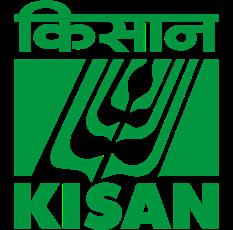













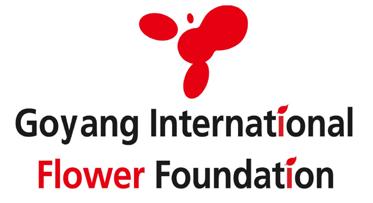




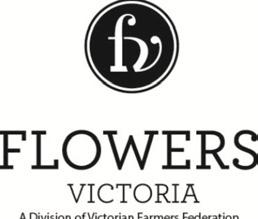





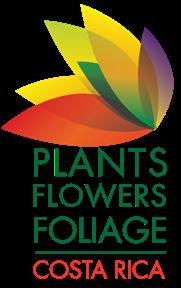







FloraCulture International encourages the pursuit of joint activities in areas of mutual interest with national, and international societies, and organisations. Agreements have been reached between FCI and leading growers and trade associations worldwide. FCI is proud to work in collaboration with:


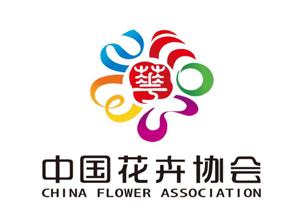



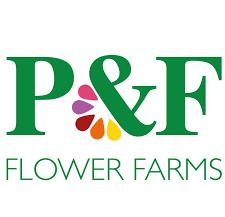





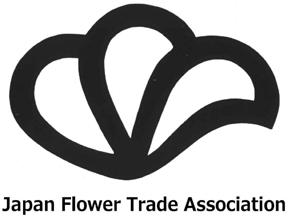









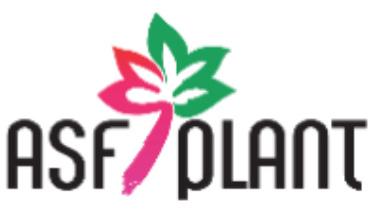
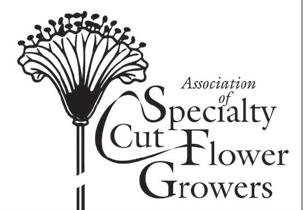
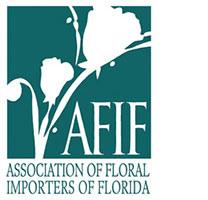

It’s celebrations all around Proflora
It’s celebrations all around Proflora this year. Colombia’s leading horticultural trade show celebrates its 30th anniversary at Bogotá’s Corferias convention centre between 4-6 October 2023. At the same time, organiser Cristina Uricoechea says there are more reasons to throw a party as the cut flower show is finally back for its first in-person event in four years.Proflora is a biennial event, its most recent edition in October 2019. We all know what happened next. The event was postponed in 2021 and 2022 due to COVID-19, so the excitement surrounding Proflora’s return is palpable, with the exhibition hall completely sold out.

Flower growers and breeders represent 80 per cent of the area, and the remaining 20 per cent is dedicated to suppliers and service providers. From more than 18 countries worldwide, these industry leaders will present their latest products, innovative solutions, and cutting-edge technologies, making Proflora a global hub for the flower trade. With over 7,000 professional visitors and buyers expected to attend from more than 60 countries, Proflora 2023 is set to be an international gathering of unprecedented scale. Attendees will be amazed by the diversity of flowers and foliage, showcasing an exquisite tapestry of colours, shapes, and scents. Everyone from industry veterans to emerging businesses will find opportunities to establish new connections, forge partnerships, and expand their horizons. The agenda is brimming with engaging activities, including flower farm tours, the prestigious Outstanding Variety Competition, an awards ceremony, and culminating with an unforgettable closing party celebrating the 30th anniversary of Proflora. Visit AIPH/FCI at Proflora to learn about our magazine or discuss AIPH membership with Senior Relationship Manager Treve Evans at Stand 2606.
Regarding farm tours, the Flanders’ Agricultural Marketing Board (VLAM) invited FCI to see a cross-section of ornamental horticulture in Antwerp and the Kempen, aka Campine. Episode one takes us to Buxus king Herplant from Beerse and succulent grower Belgicactus in Westerlo. FCI also had the honour to speak with Professor Francesco Ferrini, Full Professor of Arboriculture and Urban Forestry at the University of Florence and President of the Nursery Production District of Pistoia, to discuss the benefits of a triple helix approach, a trilateral network of organisational links between the university, the government, and the nursery stock industry. He also shines his light on plants as being the most complex component of an urban requalification project, the need for climate-resilient trees and plants and the debate on native versus exotic species. Page 8.

GreenTech 2023 already proved it: the acceleration in take-up of LED lighting is seeing dozens of suppliers offering lighting to growers, making it confusing to pinpoint what best will suit your situation and crop. Helping green professionals hack through the supplier jungle is “With HPS, you had a choice between a couple of power outputs and a couple of different reflectors, and that was about it,” says Paul van der Valk, international sales manager for Netherlands-based supplier Hortilux Schréder.

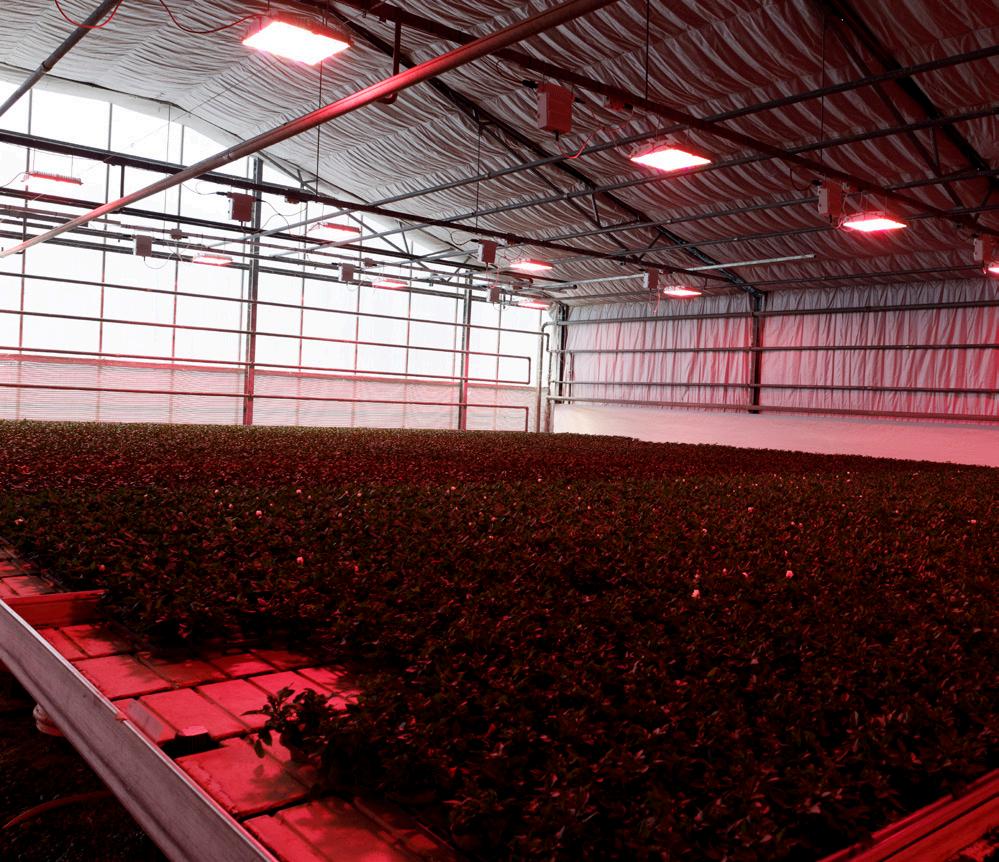
FROM THE EDITOR FLORACULTURE INTERNATIONAL OCTOBER 2023 4 08 14 20
FCI Editor Ron van der Ploeg
14
Where ornamental trees and plants grow
FEATURES
20 TECH
The LED light dawns massively on horticulture

22 TECH
A step beyond just light
26 SPRING BEDDING
FloraCulture International (FCI) is an independent trade magazine with the largest circulation for a world publication of its kind. FCI is published for the ornamental horticulture industry by the International Association of Horticultural Producers (AIPH). It is published 11 times per year worldwide.

Contributing writers: Patrick Barendse, Martin Deasy, Spence Gunn, Maurizio Lapponi, Rebecca Nordin, Hannah Pinnells, Marta Pizano, Ron van der Ploeg, Audrey Timm, and Rachel Wakefield. Contact: info@floracultureinternational. com. Address: FloraCulture International, Horticulture House, Chilton, Didcot, Oxfordshire, OX11 0RN, United Kingdom. Editor: Ron van der Ploeg, ron@ floracultureinternational.com Worldwide Advertising Office: Angie Duffree, angie@floracultureinternational.com. T. +31 6 403 277 35. Magazine designer: Rachel Wakefield. Cover image: Aldo Colombo. AIPH ©2023 FloraCulture International magazine. All rights reserved. Publisher is not liable for the content of the advertisements. Photographs by permission of copyright owners.
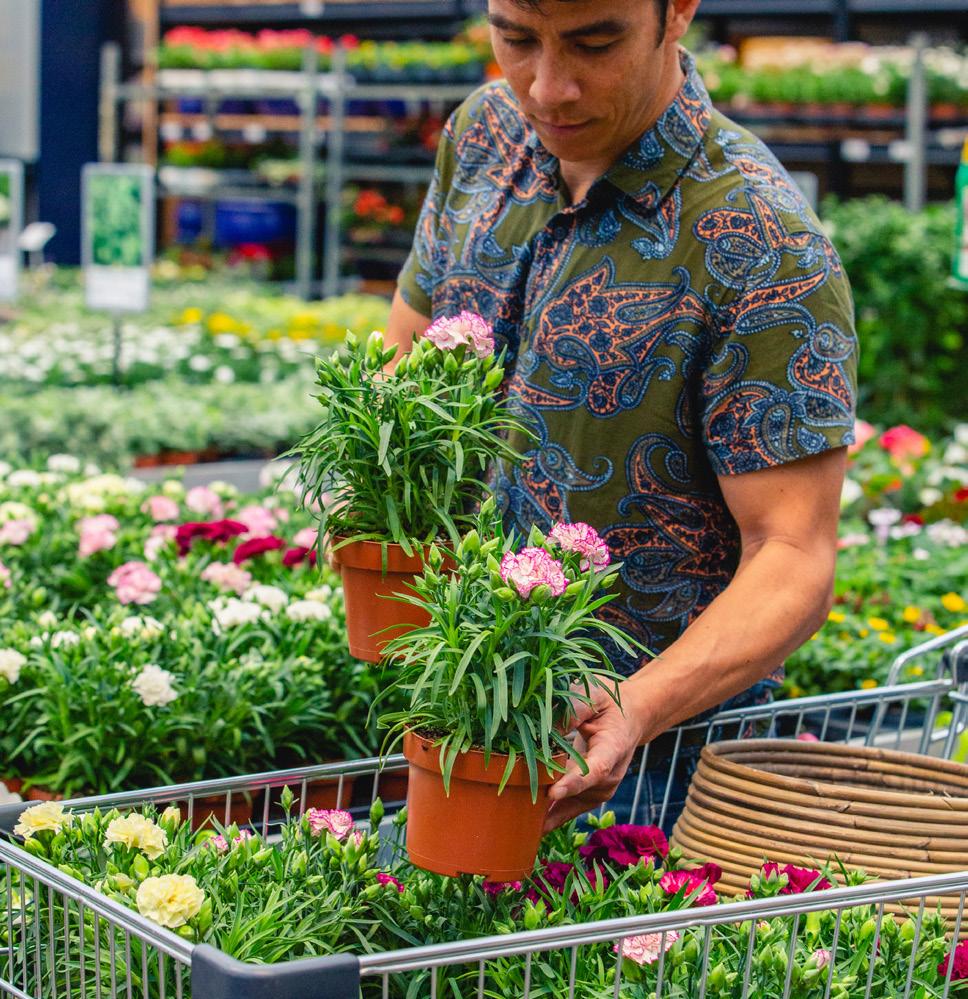
CONTENTS 26 22 32
2023 VOLUME 33 NUMBER 10
OCTOBER
COVER STORY
IN FLANDERS FIELDS
The state of the pot carnation
36 AIPH INDUSTRY CONFERENCE
VOICES 04 FROM THE EDITOR 07 SUCCESSFUL SUCCESSION PLANNING IN EVERY ISSUE 06 WORLD NEWS 08 VIS-À-VIS 30 GREEN CITY POST 32 EXPO-SURE 34 SAVE THE DATE WWW.FLORACULTUREINTERNATIONAL.COM 5
A focus on Korean floriculture and environmental footprinting.
Dutch Flower Group to host its annual DFG Awards at Trade Fair Aalsmeer
The Dutch Flower Group (DFG) will host its annual ‘New Perspectives’- themed Dutch Flower Awards ceremony at the Aalsmeer Trade Fair on Wednesday, 8 November, recognising all the hard work of the company’s suppliers.
Nine cut flower and ornamental plant growers will battle it out to win DFG’s prestigious Dutch Flower Award, which identifies successful and growing companies.

Now in its 21st year, the prestigious accolade recognises hardworking, outstanding horticultural entrepreneurs who demonstrate excellence and extraordinary success in innovation, product quality, supply chain management and commitment to sustainability efforts. All candidates are suppliers with whom the Dutch Flower Group has a tried and tested relationship.
The nominees in the
Cut Flower category are Beaumonde, Sunrise and Zwettulips. Vying for the award in the Ornamental Plant category are Ansu, Kwekerij Mostert Nieuwerkerk and Plant World. Marginpar from Kenya, Rosefruits/ Eric Stokman from Serbia and Monarch Flowers from Portugal are nominated for the International Grower Award. DFG will also present the Preferred Partner Award. This award was created in 2015 in addition to the Dutch Flower Awards. It recognises supply chain partners for the dedication and forwardlooking perspective they use in working together with DFG.
DGD whitepaper shows how India is rapidly becoming a horticultural powerhouse
Dutch Greenhouse Delta (DGD), a provider of Dutch expertise in protected cropping, has published a whitepaper outlining the key areas for action that could help make horticulture in India more efficient, safe, and sustainable.
The whitepaper discusses India’s challenges, opportunities, and solutions in horticulture. Also, several successful projects with Dutch innovations are being presented.
Although the Indian greenhouse horticulture sector has far from matured, it offers plenty of opportunities India is a rapidly growing giant, with an average economic growth of 7 per cent a year and a fast-increasing middle class demanding
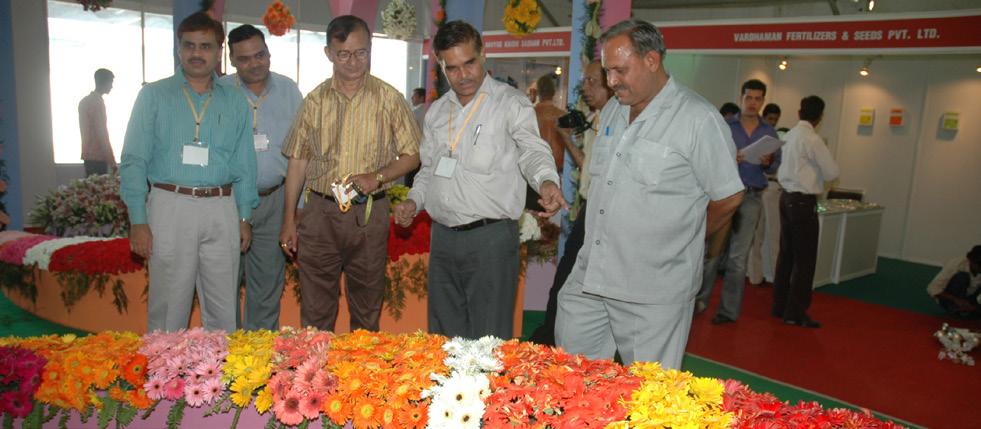
quality products. The country is the world’s number two producer of vegetables and fruit and could become the primary food exporter in the Asian region. Also, the government has a favourable investment climate.
On the other hand, India faces challenges such as water supply, extreme climate, harvest security and a poor functioning market chain.
The current food production method is inefficient and can’t supply the growing population
The Dutch Flower Group (DFG) is a globally acting group of 30 trading companies. Together, they lead the import, export, trade, and market development of cut flowers, bouquets, cut foliage and plants. They supply to specialist traders
with enough fresh, affordable, safe, and sustainably grown food.
The country requires upgrading the existing horticulture to achieve higher production, consume less water and fertilisers, and achieve better food quality.
Together with the Dutch Greenhouse Delta and Dutch horticultural cluster, India can convert food supply challenges into opportunities.
Desh Ramnath, Director of DGD India, explains: “The Indian government is taking steps to facilitate investments in agri-food technology to realise modernisation.
(florists) via wholesalers and multiple retailers (supermarkets, DIY stores and garden centres). With its 5,000 employees, Dutch Flower Group achieved a turnover of €2.3 billion in 2022, exporting to 100 countries worldwide.
They recognise that the Dutch horticultural knowledge cluster is unique due to its structured and integrated approach to horticultural projects. Because DGD, with all its partners, can provide complete solutions, it has the key to the main parties and upcoming projects.”
Several Dutch projects and innovations have been realised over the last years, presented in this whitepaper. The whitepaper can be downloaded from the Dutch Greenhouse Delta website:
www.dutchgreenhousedelta. com/focus-countries/india/
WORLD NEWS NETHERLANDS
INDIA
FLORACULTURE INTERNATIONAL OCTOBER 2023 6
The 2022 Dutch Flower Awards winners on stage with the Dutch Flower Group Executive Committee.
Keukenhof announces a new CEO: Sandra Bechtolt

The world’s largest spring garden, Keukenhof, has appointed Sandra Bechtolt as its new Chief Executive Officer, effective 1 October 2023.
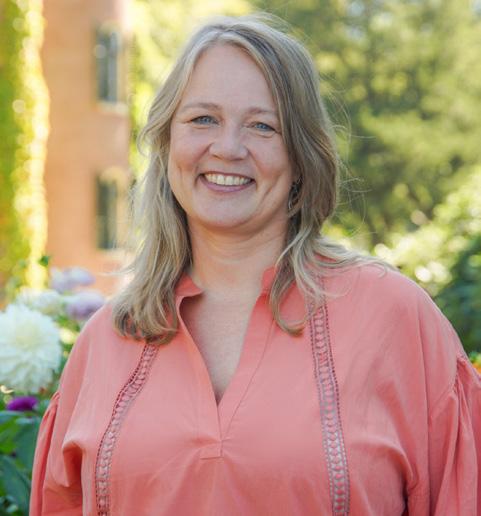
Previously working at Museum Huis van het Boek (The Book House) in The Hague as director, Bechtolt succeeds interim director Jeroen Duyster, who resigned in June this year. Between 2012 and 2022, Keukenhof’s managing director was Bart Siemerink. Bechtolt brings with her a wealth of experience in marketing and communications, having worked for the Rembrandt House and the Netherlands’s National Railway Museum in Utrecht. In 2021, she joined the Supervisory Board of the Kinderdijk (a network of well-preserved 18th-century windmills) World Heritage Foundation.
Commenting on her new role within Keukenhof’s board of directors, Bechtholt says, "Each spring, visitors worldwide flock to Keukenhof to enjoy a spectacle of colours and perfumes. Tulips have captured the imaginations
SOUTH KOREA
of millions, and I am one of the fans. Keukenhof offers plenty of opportunities for spectacular storytelling as it is a place where magic happens. Keukenhof is a multi-faceted estate, including a beautiful castle, a world-famous spring garden and a highly motivated organisation. It’s truly an honour and a challenge to help bolster Keukenhof’s position with people from within and outside the organisation.”
AIPH welcomes new members from across the globe at its 75th Congress
The International Association of Horticultural Producers (AIPH) welcomed new members at its General Meeting on September 19, 2023, in Suncheon, Republic of Korea, during the AIPH 75th Annual Congress.
At the General Meeting, members agreed upon the following applications from Asociacion de Comercializadores de Planta Ornamental (ACPO) from Spain, and Affiliate Membership applications from Greenhouse Sustainability, HildverdaFlorist, Goyang
SUCCESSFUL SUCCESSION PLANNING
Second-generation Patrick Barendse is a production manager at Holambra-based potted plant nursery www.symphony.com.br, where he and his brother Frank and sister Claudia took over the potted plant nursery from their father, Geraldo, in 2020.
“Business succession planning in ornamental horticulture is a muchdiscussed topic these days. Flower and plant-producing companies are increasingly becoming large-scale, complex operations. So horticultural business owners need to think about what happens to the company when they pass it down to a new generation or a business partner.
Ornamental horticulture in Brazil is a relatively new sector of the economy. It began to expand in the 1980s after the Dutch people from Holambra set up their first flower auction.
Back then, many ornamental growers had little money but showed an incredible willingness to work hard and grow their businesses.
The pertinent question is how to efficiently start up succession planning efficiently. Here at Symphony in Holambra, we have been working on it for the past five years.
We have learned so far that there is no perfect formula to make the transition. Every family is unique, so every succession is unique. However, a few common steps can help pave the way for the next business ownership.
Step one: Making rules and establishing governance. Before discussing the family’s patrimony, the important questions one should ask are: What are the strengths and weaknesses of future leaders in the family or the business?
If one of them is not interested in working for the company, who else can take that place?
What´s the best role for each person in the company?
It’s about asking questions on all matters so that you can avoid a conflict in the family partnership. Simply put all your answers on a piece of paper and sign it.
International Flower Foundation, Taylor Bridges Consultancy, and Transport Management Services (TMS Global).
By joining AIPH, members can gain insight into global industry trends and establish international alliances that support the industry. www.aiph.org/members
Step two: Patrimony succession
There is no need to rush on this part. However, it is very important that business succession takes place when the successor still has a clear mind, and the family is in harmony. Nothing is certain in the future.
The formalities mentioned above must be done to complete the process. Still, real succession occurs when the old generation passes the company’s aim and the owner’s life experience and when they connect with the new generation’s fresh vision that helps create the company’s future DNA. Always remember that what got you here might not get you to the future.”
WORLD NEWS WWW.FLORACULTUREINTERNATIONAL.COM 7
VOICES NETHERLANDS
Sandra Bechtolt appointed CEO of Keukenhof.
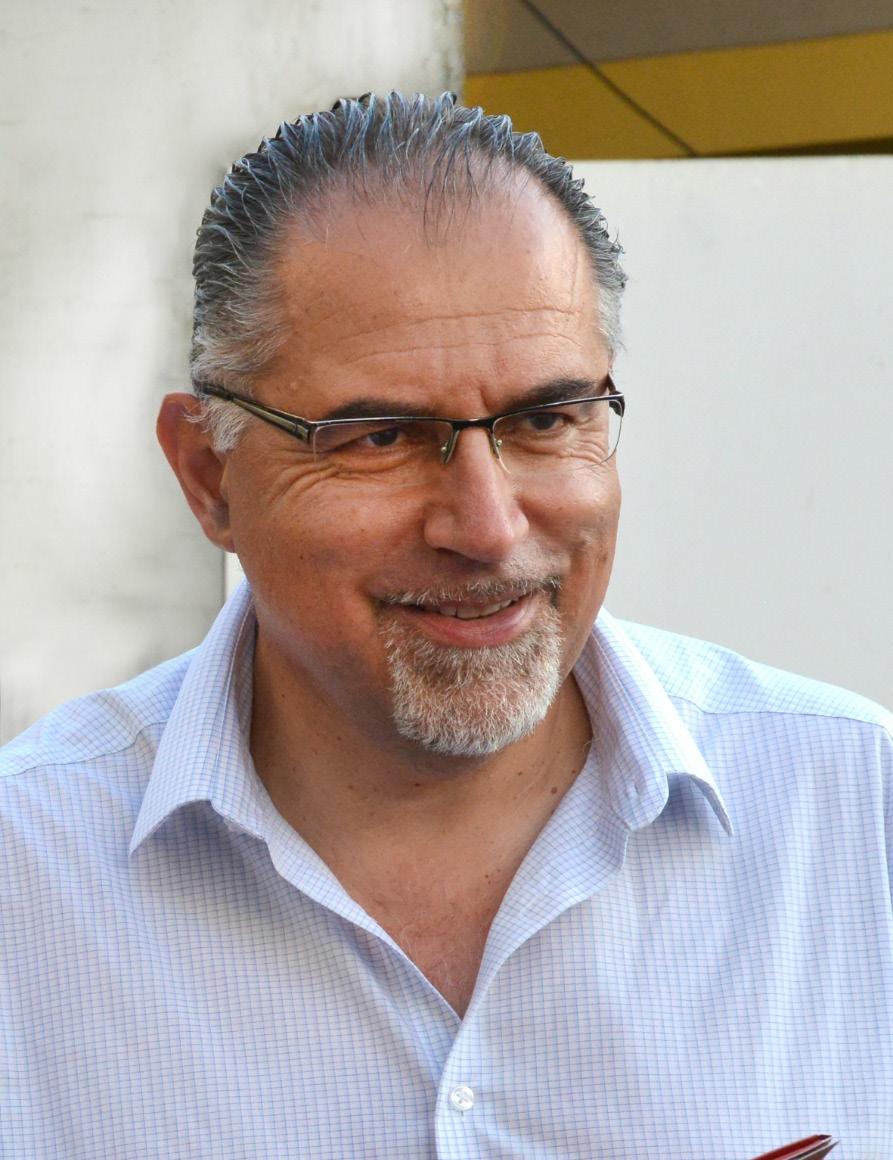
FLORACULTURE INTERNATIONAL OCTOBER 2023 8 VIS-À-VIS
Francesco Ferrini is a Professor of Arboriculture and Urban Forestry at the University of Florence and President of the Nursery Production District of Pistoia.
THE RIGHT TREE IN THE RIGHT PLACE
Professor Francesco Ferrini, Full Professor of Arboriculture and Urban Forestry at the University of Florence and President of the Nursery Production District of Pistoia, shares insights on the game-changing benefits of a triple helix approach — a trilateral network of organisational links between university, government, and nursery stock industry. He says plants are the most complex component of urban requalification projects and discusses the need for climate-resilient trees and plants and debates on native versus exotic species.
For Europe, and Italy in particular, 2022 was a disastrous year from a climatic point of view, aggravated by a severe energy crisis and by a summer affected by strong heat waves and prolonged drought, with increasingly damaging and catastrophic effects. The immediate, unanimous, and imperative cry of politicians, public administration and companies more or less responsible for climate-changing gas emissions was: 'Plant trees'. Not thousands, not millions, but billions of trees. In 2023, however, not even a faint whisper about this emergency has been heard. Evidently, they have found other solutions or priorities to address what have so far only been called climate
anomalies. We wanted to hear the expert opinion on this topic from Professor Francesco Ferrini, Full Professor of Arboriculture and Urban Forestry at the University of Florence and President of the Nursery Production District of Pistoia. Ferrini is an esteemed professional and a shining example of how the university and industry can successfully work together.
FloraCulture International: I am a great believer in active collaboration between universities and nurseries. Do you think it will bring prestige and credibility to the nursery world? Do you think the politicians consider the time constraints of tree production during talks?
Robinia pseudoacacia, aka false acacia, or black locust, is a medium-sized deciduous tree originating from the United States. It's a popular garden tree, although it has naturalised in some parts of North America, Europe, Africa, and Asia and is sometimes considered invasive.
Francesco Ferrini: I have always been close to nurserymen, and with their collaboration, I have undertaken important research. I sincerely hope that my presidency of the most important nursery district in Italy, if not in Europe, will lead to a better dialogue with politicians and the Public Administration. In institutional meetings, we have often explained the shortage of tree production in European nurseries. Still, the Public Administration must contend with the strenuous search for trees like the companies receiving public greenery contracts. Having contracts to honour the industry needs help in completing the work. That is why we have asked to find a solution that can plan production to get the quantities, species, varieties, and correct measures to comply with the commitments undertaken. In this discussion, it is crucial to recognise ‘distractions’, i.e. promises or solutions touted as ‘unique’ or better or whose feasibility and cost-effectiveness are described as far superior to the actual ones. These are often strategies or technologies that are indeed viable but are far from being able to solve a transversal problem such as climate change and which instead risk “distracting” public opinion from the necessary actions for decarbonisation of the energy, industrial, residential and transport sectors. Undoubtedly, ‘planting trees’ is a solution apparently without drawbacks, which appeals to everyone and inspires a positive vision of the future by evoking actual benefits (urban cooling, absorption of pollutants, physical and mental well-being) and others that should be analysed more seriously (carbon dioxide absorption).”
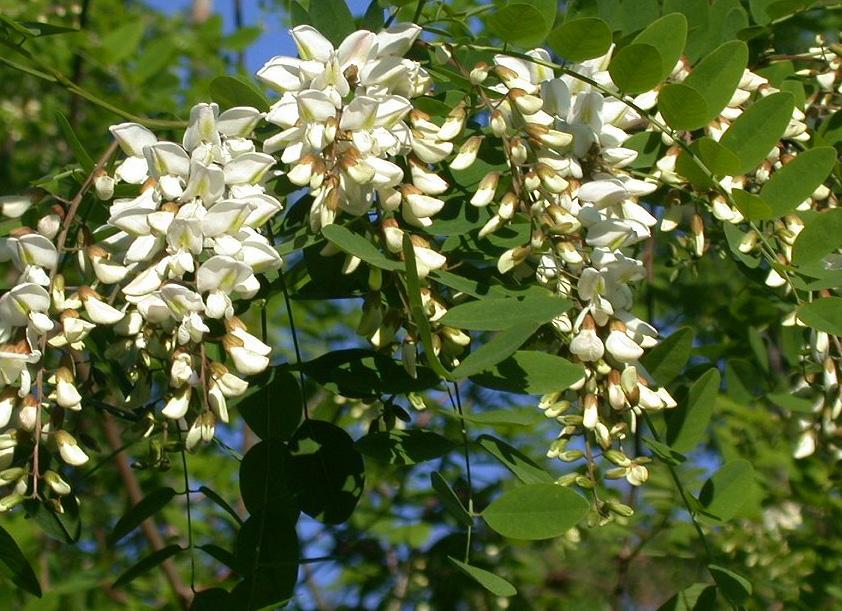
WWW.FLORACULTUREINTERNATIONAL.COM 9
AUTHOR: MAURIZIO LAPPONI
VIS-À-VIS
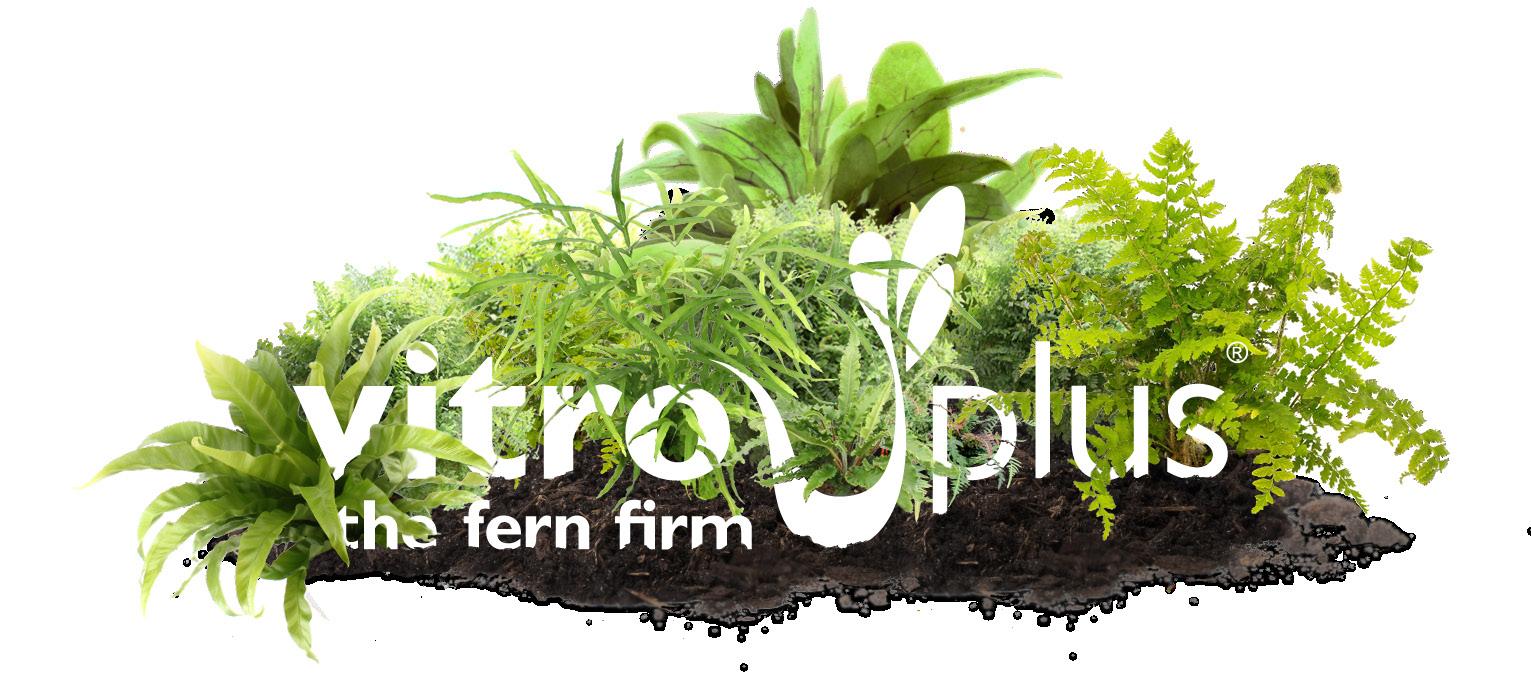



Your complete source for tropical and perennial fern starters Vitro Plus B.V. Roterij 26, 4328 BA Burgh-Haamstede The Netherlands
Gleditsia triacanthos is a very rustic exotic genus and will, with increased probability, provide superior growth performance and, consequently, environmental benefits.

‘WE ARE WELL AWARE THAT THERE IS NO SUCH THING AS THE PERFECT TREE, BUT WE MUST STRIVE INSTEAD TO PLANT THE RIGHT TREE IN THE RIGHT PLACE AND ENSURE ITS CORRECT AND ECONOMICALLY SUSTAINABLE MANAGEMENT’

By 2030, in addition to the 145 billion square metres of buildings already existing on Earth, there will be a further 73 billion square metres of new buildings. So future city projects are being studied where 'green' should play a fundamental role. Does one consider the exceptional changes we have mentioned, destined to become 'normality' for the choice of trees? How do you imagine this new scenario?
“Plants are perhaps the most complex component of an urban requalification project; complex because they are living beings, and they change in size (and sometimes even in shape), and, if we reference deciduous plants, they also mutate with each season. The choice to use various botanical species has always been focused on their aesthetic qualities, but today, other parameters, not only technical, must be considered when choosing suitable species for an environment.”
WWW.FLORACULTUREINTERNATIONAL.COM VIS-À-VIS 11
Future research will have to provide answers to important questions. Could one of the first goals be the search for species of trees and shrubs that are less vulnerable and sensitive to extreme drought and heat waves?
“The decision to base our choice on criteria that take into account both technical and aesthetic characteristics becomes significant if, for example, we come to realise that the warmer microclimate of cities can be advantageous in cold climates, allowing the cultivation of species that are less tolerant to low temperatures and hence the choice of a wider range of exotic species and phenotypes than would normally be usable in such climates. But it should also be kept in mind that, somewhat less positively, the warmer microclimate may cause early sprouting or prolong the growing season, making the trees susceptible to late spring frosts or eventual early autumn frosts. And again, in warmer climates, high temperatures and reduced water availability, especially in paved areas, can lead to localised drought conditions and limit the choice of species.”
Which species are most affected, and what is the recovery time of urban trees and shrubs suffering from this situation?
“In particular situations, exotic species might perform better than trees that are native to the area but which have evolved in a different climate and would show serious difficulties thriving in our cities, where climatic conditions and soil characteristics may be completely different from those of a 'natural' environment. Native plants do not necessarily survive in these conditions better than exotic ones.”
Do you have any actual examples to confirm this?
“One example applies to all: the alder is a typical species found in humid areas and river banks in Tuscany, hence indigenous, but if it is planted even a few dozen metres from the river, where it naturally grows, in a sunny paved square, it will hardly survive. In the same environment, a Gleditsia, a very rustic exotic species, will, with increased probability, provide superior growth performance and, consequently, environmental benefits.”
Alnus
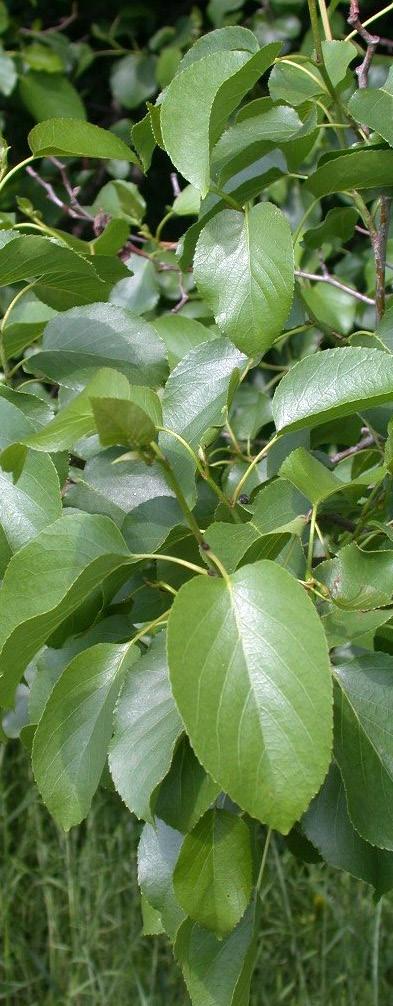
FLORACULTURE INTERNATIONAL OCTOBER 2023 12
cordata, aka Italian alder, is a pyramidal, fast-growing, small to medium-sized, deciduous tree that is native to Corsica and southern Italy.
Is it possible to calculate the mortality rate of the species?
“Certainly, it is possible to predict the mortality rate of the species, using the distribution ranges of the species and the functional traits of the plants, i.e. all the morphological, physiological and phenological characteristics of the plant itself that influence its overall fitness through their influence on survival, growth and reproduction, such as specific weight of wood and its density, plant height, crown size and leaf traits, such as leaf size or area, specific leaf area, relative water content, foliar dry matter content, foliar nitrogen content, foliar phosphorus content, stomatal conductance, photosynthetic rate and intrinsic water utilisation efficiency. It would be necessary to attach microchips to the plant that give data to a server that can evaluate them daily. We are currently researching this project.”
It is necessary to raise a more widespread awareness of how complex this subject is through continuous questioning and increasing studies related to the many issues, such as the species to be used in an urban environment and beyond, the choice of trees with greater retention and storage of CO2, and pollutants, and the native and exotic species capable of coping best with the increase in temperature. Considering all these variables, how do you think interactions between species will change?
“If we must take into account all these factors, we should not rule out a priority use of exotic species. Still, once their potential for new plantings has been assessed and compared with that of native species, we will try to introduce them where they can maximise the benefits they provide in terms of CO2 sequestration and reducing pollutants. On the other hand, it should be emphasised that their excessive use should not lead to a
kind of 'plant globalisation' to the detriment of species typical of certain areas. Autochthonous, indigenous, or naturalised vegetation can be the ideal backdrop to enhance the ornamental characteristics of certain exotic species, creating contrasting elements that allow the rare species to be fully appreciated. It is not easy to imagine (although it could happen, unfortunately, because of the Red Weevil) our waterfronts in Southern Italy or the Riviera Ligure di Ponente without palm trees (which are all exotic apart from Chamaerops humilis) or the gardens of the islands and almost all coastal strips without Bougainvillea or without other exotic species that have now become part of the classic landscape of our coastal and even lakeside areas. It can, therefore, be stated that a tree which is native or non-native in a different climate has a relative significance. What really matters is whether the characteristics and performance of the trees are compatible, even if they do not enhance the environment where we want to place them, obviously avoiding invasive species. Sometimes, there is confusion and a tendency to associate the term exotic with the potential for invasion of the species. Most non-native or exotic species are harmless. An exotic species is called invasive when it harms the ecosystem, such as the Ailanthus, Paulownia, Robinia or Broussonetia papyrifera. The main difference between exotic and invasive species is that exotic species are harmless to the ecosystem, while invasive species are damaging to the ecosystem. Rather than comply with environmental regulations that exclude the use of exotic species in new projects, it would be more reasonable to stimulate landscape architects to design pleasant green spaces using a greater variety of species, whether native or exotic, seeking out the most suitable or adaptable ones on a case-by-case basis. A 100 per cent native' objective, although desirable, may not be the best choice for the site we are dealing with at the time. We are well aware that there is no such thing as the perfect tree, but we must strive instead to plant the right tree in the right place and ensure its correct and economically sustainable management.”
In Italy and Europe, nursery workers and gardeners have achieved high-quality landscaping production, design and creation results. Don't you think the sector really lacks the economic valuation of greenery? Why can't we create a European algorithm that can calculate the daily amount of CO 2 absorbed by the trees in our gardens?
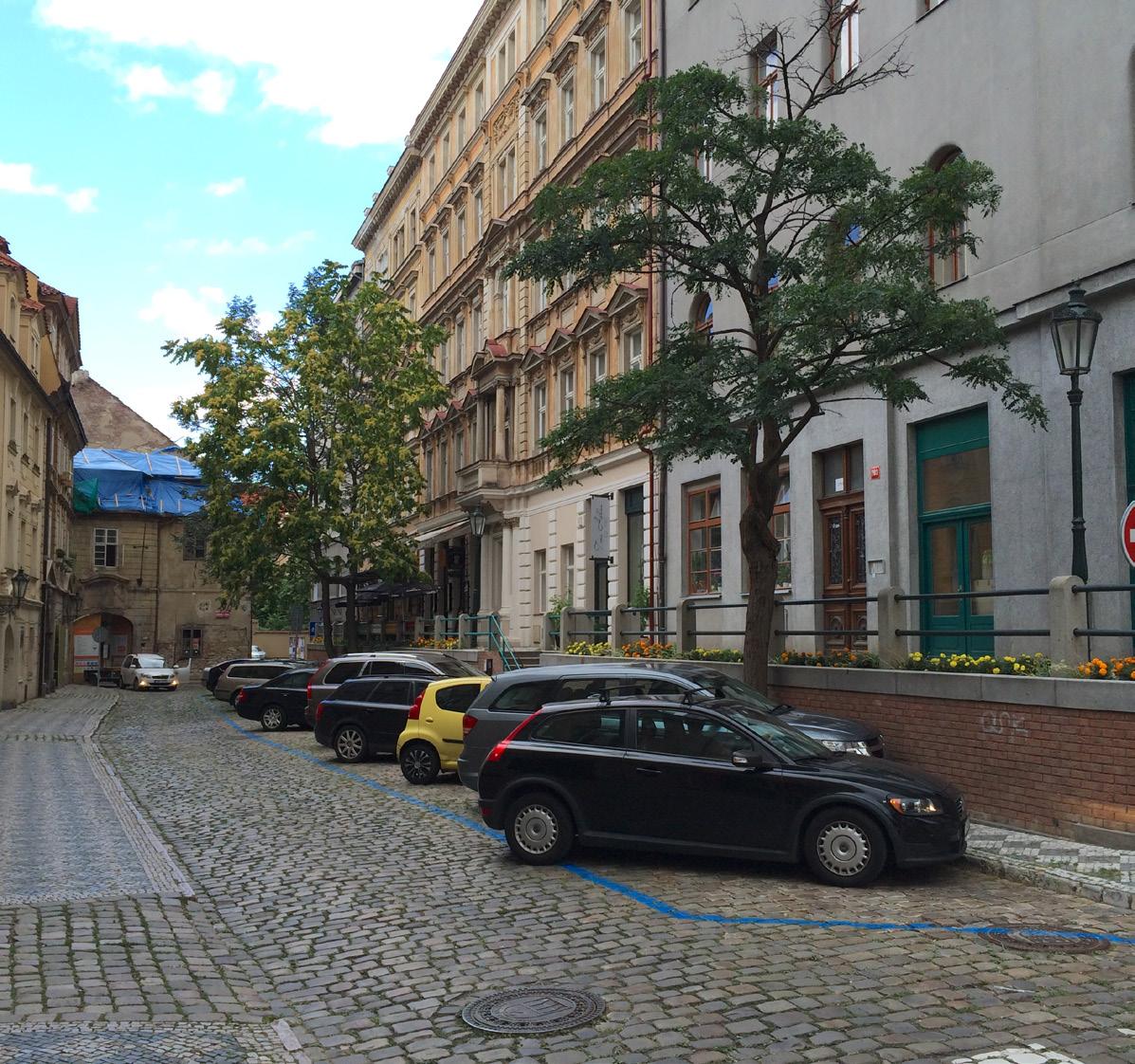
“It is not at all easy to create the algorithm you mentioned, although many institutions are working on it, and some recently published results are quite encouraging. However, there is still time to say that we have a reliable formula or programme.”
• Professor Ferrini concludes the interview with this note of doubt that is probably dictated not so much by science as by the long-standing knowledge of the world of green operators, often conflicting with the common goals to be achieved. Surely, our united sector would attain unreachable and unimaginable results for everyone.
WWW.FLORACULTUREINTERNATIONAL.COM 13
Ailanthus and Robinia in a rather unhospitable urban environment.
In Flanders Fields, where ornamental trees and plants grow
The Flanders’ Agricultural Marketing Board (VLAM)
invited FCI to see a crosssection of ornamental horticulture in the province of Antwerp and the Kempen, aka Campine. Episode one takes us to Buxus king Herplant from Beerse and succulent grower Belgicactus in Westerlo.
The self-governing Flanders Region includes the provinces of Antwerp, East Flanders, Limburg, Flemish Brabant, and West Flanders. Ornamental horticulture geographically concentrates in East Flanders, with Wetteren and

Lochristie being epicentres of nursery stock and flowering pot plant production, respectively.
In the province of Antwerp, nursery stock and potted plant growers are much more scattered. So, the tiny town of Lier, 20km east of Antwerp, is a great location to explore seven of the region’s leading companies.
Because departing from Lier’s city centre, they are all within a 50km radius.
Lier, at the confluence of the rivers Grote and Kleine Nete, attracts tourists and sightseers keen to see its Brabant/Rococo townhall and adjacent UNESCO World Heritage Belfort, plus its iconic Zimmer

FLORACULTURE INTERNATIONAL OCTOBER 2023 14
AUTHOR AND PHOTOS: RON VAN DER PLOEG COUNTRY
PROFILE
The Aragon Bridge in Lier (Photo courtesy: Lier Tourist Board).
Tower named after clockmaker Zimmer, who presented his native town with a Jubilee Clock in 1930 when Belgium celebrated its Centenary. For the sportier types, Lier also hosts the ‘Abarth Works Museum’, the place to be regarding Abarth sports cars, spare parts and genuine Abarth engines.
The famed French poet and novelist Victor Hugo visited Lier by stagecoach in 1837 and marvelled at the city’s beauty. On a much less romantic note, Lier is engraved in Belgium’s national memory as it was the scene for a car accident that killed the then extremely popular singer Louis Neefs and his wife in 1980.
Lier is known as ‘the gateway to the Kempen’, aka the Campine, a cross-border area that extends across the frontiers of Belgium and the Netherlands.
Campine is a hybrid form of the Latin word Campinia, meaning open field. In the late Roman era, people also named the land Taxandria, a homage to the
then omnipresent Taxus (yew) growing naturally in the wild. Some historians sustain that the Campine’s wild Taxus died out because people in the Middle Ages discovered that the tree makes good crossbows and bolts, leading to a massive uprooting of trees.
HERPLANT
Today, brothers Didier, Luc and Louis Hermans ‘domesticate’ Taxus and Buxus trees using selective breeding to create more disease and pest-resistant, visually appealing, scientifically tested, and well-rooted varieties. Working in nursery stock is in the Hermans’ genes. Their grandparents earned a living as professional tree trimmers while their parents owned a modest conifer nursery.

Considering the lousy patch the Boxwood (aka Box or Buxus) in particular has gone through over the past two decades, their company Herplant, which started in 1985, deserves credit for

Beautifully designed Buxus garden at Herplant’s headquarters in Beerse. Left to right, son and father Alec and Didier Hermans.
perseverance in turning adversity into an opportunity.
The adversity began in the 1990s with the arrival of the invasive fungus box blight (Cylindrocladium buxicola, syn. Calonectria pseudonaviculata). It worsened when the first box tree caterpillar (Cydalima perspectalis) emerged in the Netherlands and Germany in 2006. Since then, Box Blight and Box Tree Moth continue to damage, causing debilitating defoliation and decimating ornamental and wild boxwoods.
BETTERBUXUS
To turn the tide, Herplant joined forces with the Flemish Institute for Agricultural and Fisheries Research (ILVO) in 2007 in a breeding programme with slow-germinating Boxwood seed and the need for simultaneously available flowers to crossbreed being two of the most significant challenges.
Their work resulted in BetterBuxus, the industry’s first-ever collection of scientifically bred blight-
WWW.FLORACULTUREINTERNATIONAL.COM 15 COUNTRY PROFILE
resistant boxwood. The brand name (in the USA, aka Better Boxwood) comprises four varieties. BetterBuxus ‘Heritage’ is similar to the standard Buxus sempervirens, though a little more compact. However, Didier Hermans quickly adds that BetterBuxus and Buxus sempervirens originate from different genetics and are worlds apart. He says, “It is important to recognise that the genus Buxus comprises more than 100 species, most growing in tropical regions.”
‘Rennaissance’ is a low-growing, small-leaved variety suitable for low-box pattern designs and only needs clipping once a year. The fastest growing is ‘Skylight’; its vigour makes it well-suited to topiary and tall, cloud-pruned hedges. ‘Babylon Beauty’ has a low, spreading habit useful for large ground-cover sheets. Meanwhile, trials involving a fifth sibling within the BetterBuxus family is a work in progress at the gardens of Het Loo Palace in the Netherlands.
PROPAGATION
A purpose-built greenhouse at Herplant’s headquarters in Beerse hosts lush-looking BetterBuxus mother stock. Lighting and soil heating enable a harvest frequency of six annually, yielding 120,000 cuttings annually.
Experienced plant propagator and Buxus grower De Vos-Hertschap from Lokeren, with whom
Didier has forged many years of friendship, places cuttings into a moistened sandy medium using 104-hole, 84-hole or 60-hole trays. Depending on the season, the roots develop within an average of two months, in midsummer two weeks earlier. Once the plug plant’s roots have extended in all directions, they are hardened off and repotted into P10.5 (landscaping) or P13 (garden centre customers). Then, these semi-finished plants return to Herplant, where they grow into saleable plants.
De Vos-Hertschap and Herplant place two cuttings per pot, and Herplant take pride in giving plants the right amount of space in the container field, allowing them to grow into beefy and resilient specimens.
This growing method is in contrast to the common practice of uprooting Buxus sempervirens with a special machine that lifts plants with the soil and the immediate root system. These cut-off Buxus rootballs are subsequently placed into a bigger pot, with sales of these ‘pot-pressed’ items frequently modelling on tailormade DIY or discounter orders. Didier notes, “The problem with ‘pot-pressed’ is that when hot weather arrives, you’ll have to put uprooting on hold temporarily. In contrast, how we do it allows us to sell well-rooted plants all year round, even when temperatures are scorching hot.” In Taxus, Herplant propagates mostly in-house with an additional one-year-old seedlings purchased in Zundert, the nearby epicentre of nursery stock production in the Netherlands.
TAXUS
Taxus is finished in P 10.5, 1.5, 5, and 12-litre pots with bigger rootballed plants grown in the field. Taxus specimens such as low-growing and compact Taxus baccata ‘Tiny T’, a KVBC silver medal winner at last year’s GrootGroenPlus show, Taxus media ‘Eleganza’ with male flowers only (no berries) and fine dark green needles plus the curlier and long-needled Taxus baccata ‘Exotica’ are primarily rooted in-house. There is no single best alternative back to Buxus, which used to be a prominent horticultural crop globally but has lost its stable ranking, says Didier, quoting 2017 figures sourced from Royal FloraHolland. He elaborates, “The Netherlands are the leading European country for Buxus, producing more than 17 million of the European total of 43 million plants.”
The 2022 figures provided by market analyst Agrimatie indicate that production areas dropped from 1,684ha in the 2011 heydays of Buxus to 612ha in 2022. This decrease in area was accompanied by a decline in the number of growers, from approximately 900 in 2013 to 100 in 2022.
It is safe to say that box blight has tested the resolve and the finances of boxwood growers worldwide,
with price cuts hammering this sub-sector of nursery stock.
Yet, despite his frustration at the media’s frequently unbalanced coverage Boxwood received, Didier Hermans always kept his belief in Boxwood intact. He is adamant this is how he and his brothers want to make their living. He says, “Considering the many suggestions for replacements of Boxwood in landscapes and gardens, nothing brings a sense of formality, reliability, and low maintenance to a garden like a Boxwood. There is no single best alternative. Herplant was one of the partners in a 2015 Ilex crenata project, heralding two PBR-protected and cuttingsraised Ilex crenata cultivars as the perfect alternative to Boxwood hedging. Gardeners planted them in historic gardens such as Paleis Het Loo in the Netherlands and Vaux-le-Vicomte in France but soon afterwards had to uproot many of them. Ilex crenata is not the best solution, as it has larger leaves than the boxwood and does not provide quite the compactness of form. Also, it turned out to be very picky regarding soils, preferring sandy soil with low pH.”
Didier thinks the market entry of BetterBuxus marks a watershed moment. It will lead to a renewed interest in Boxwood focusing on the good – year-round colour and structure to the garden and hassle-free clipping – instead of the bad. He notes, “Today, Buxus sempervirens make up 90 per cent of the market. I hope that more tolerant varieties and, naturally, our resistant varieties gain market share. Boxwood is and will remain indispensable for growing a small, ball-shaped plant for the retail market quickly and profitably. Other evergreens will not give the same result. Today, demand for Buxus tends to exceed the offer, particularly regarding the bigger pot sizes. So, for the near future, I anticipate an increase in production area again.”
It is safe to say that the first is the most severe between Box Blight and Boxwood Moth. While BetterBuxus offers a solution to the fungus, the moth still wreaks havoc. Didier explains, “The moth is here to stay,
FLORACULTURE INTERNATIONAL OCTOBER 2023 16 COUNTRY PROFILE
but if you treat your buxus twice a year at the right moment, the pest is easy to treat biologically and chemically. Products based on Bacillus thuringiensis (not admitted for the hobby market in Belgium, the Netherlands, and the UK) are very effective in combating young caterpillars. If this is not too much to ask from the gardener? We increasingly strive to make our planet greener and rally to save the Amazon while neglecting our gardens. If the moth is invasive, we should not allow it to spiral out of control; we must act now. A genus that originates from the Late Cretaceous epoch and has been growing for 74 million years must have something going for it, mustn’t it?”
BELGICACTUS
These days, the business name Belgicactus is a red herring, although it started as a cacti nursery in a 1,000m2 plot adjacent to Jozef Gielis’ home in 1985. The company’s 28,000m2 plant nursery currently resides in Westerlo and grows only succulents. Apart from its standalone line of Opuntia humifosa,
aka prickly pear, which technically belongs to the Cactaceae family, there are no prickles in sight.
“Growing cacti and keeping them pest and disease-free can be a daunting task while supply constraints in starter plants also played a part in our 2014 decision to focus on specialisation and stopping cacti production altogether,” explains second-generation Jef Gielis, who, with his brother Jan oversees the day-to-day operations of the company that grows approximately 60 varieties of Sempervivum for outdoors in pot sizes ranging between 5.5 and 23cm. Echeveria, Crassula, Sedum and Aeonium are sold as indoor plants in pot sizes 5.5 to 13 cm. In a year, Belgicactus produces between 2.5 to 3.5 million plants sold to predominantly exporters and cash and carry stores in the Netherlands and Belgium.
CUSTOMER BASE
Jef says the days when Westerlogrown succulents sold through the Dutch auction clock are long gone. “Apart from Euroveiling in Brussels, no plants are auctioned off. At the large Dutch auctions,
Sempervivums are here to stay with a 45-50 per cent volume market share within Belgicactus’ business operations.
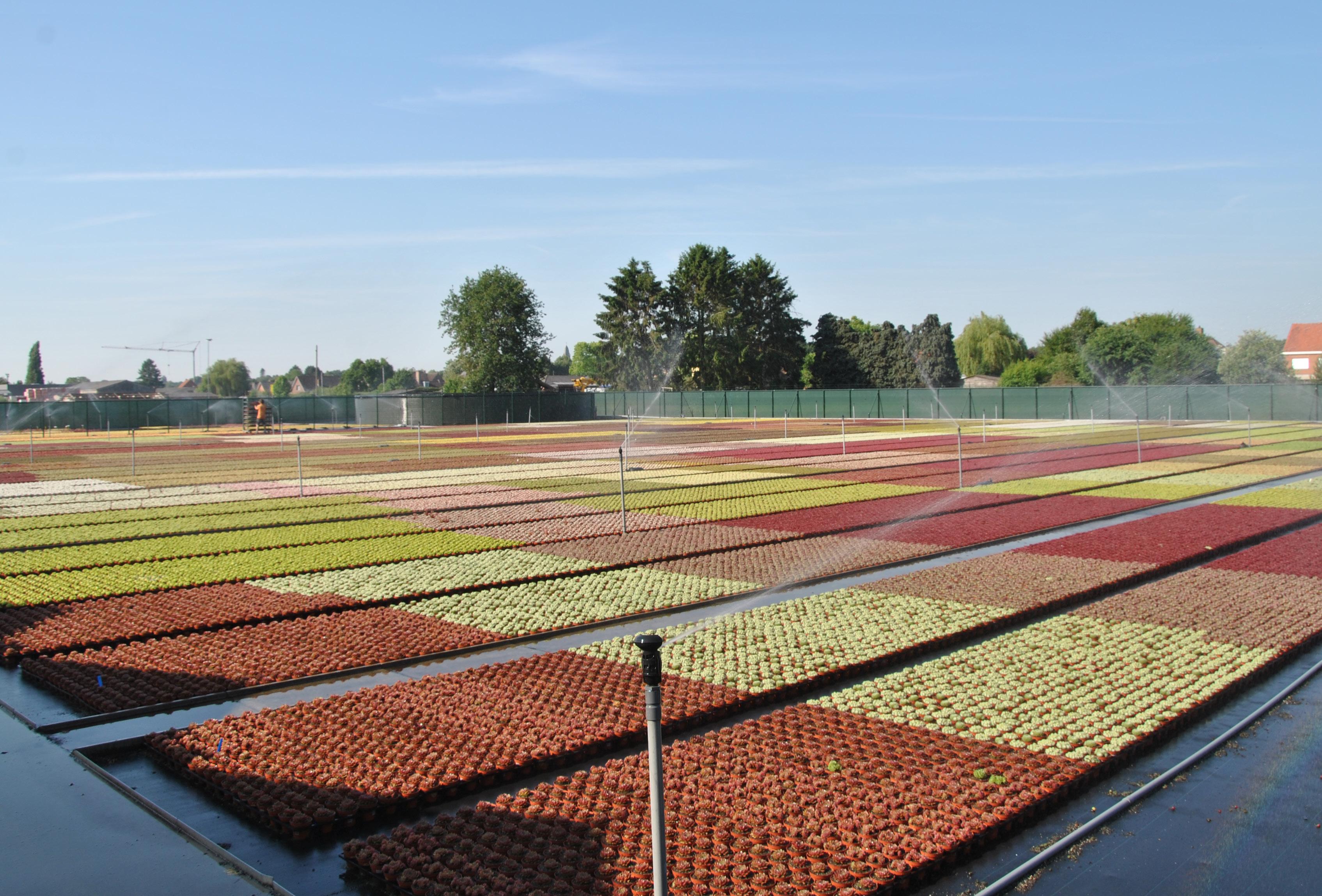
the risk is the products get snowed under, not receiving the attention and price the quality product deserves.”
Markets with strong succulent demand include Germany, the UK, Austria, Switzerland, Italy, and Denmark.
Traditional wholesalers make up most of their customers abroad. Retail is not a market segment because it would find it challenging to supply on the mass scale needed to fill retail shelves.
Jef elaborates, “Also, we feel that retail is not per se interested in bringing variety to their shelves while our motto is to offer less conventional succulents in a rainbow of colours and shapes and being a one-stop shop.”
SEMPERVIVUM
1995 marked a watershed moment in the company’s history when it added the first Sempervivums to its portfolio. Today, as its name aptly evokes, Sempervivums are here to stay with a 45-50 per cent volume market share within Belgicactus’ business operations.
Sempervivums propagate by offsets. In June and July, part of the 12 full-
WWW.FLORACULTUREINTERNATIONAL.COM 17
time staff take to the 18,000m2 lava growing beds outside to harvest cuttings and subsequently place these in 3.5cm plugs.
In the spring of the following year, these starter plants are potted in different pot sizes, with the first plants ready for shipment by the summer of the same year. But lines can be blurred as some plug plants are only potted one year later. Practices in potting have limited flexibility as Sempervivum plants begin to flower after two to three growing seasons. Jef explains, “Foliage is the main attraction in commercial Sempervivum production. So, all Sempervivums are shipped before reaching their flowering stage because, without flower stalks, more plants fit on a Danish trolley. At the consumer level, flowers add interest to the plant. After flowering, the central rosette dies, leaving many mini plants behind to replace it, and that’s an exciting process to witness.”
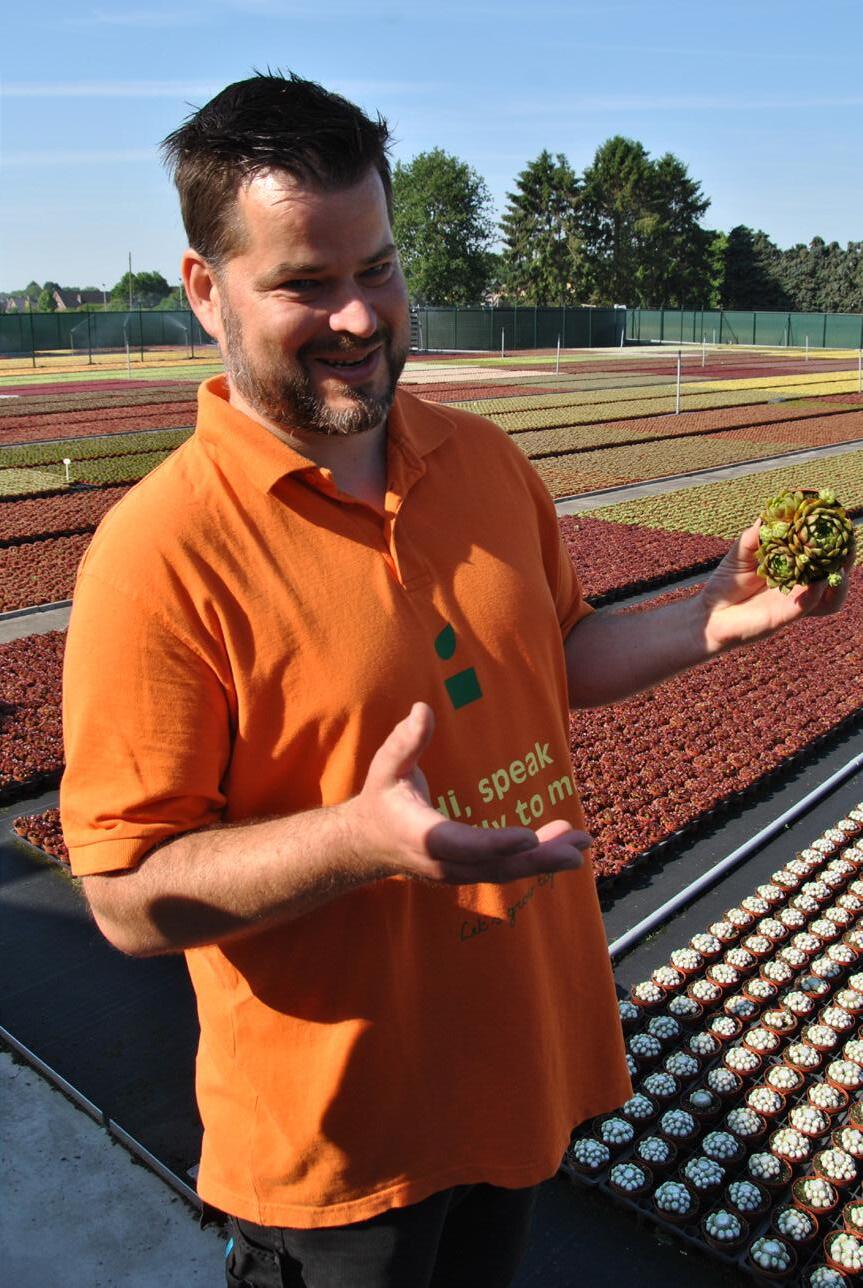
COLOROCKZ
Belgicactus puts significant marketing muscle behind its range of Sempervivum. All in-house bred Sempervivums sell under the Colorrockz brand, with plant propagators and rooting stations in Europe, the USA and Australia being granted a licence to reproduce. Today, Colorockz comprises seven varieties, all of which the company says feature remarkable colours, a well-developed root system, vigorous growth, disease and pest resistance and plant hardiness. In 2022, judges at Belgium’s horticultural trade show Florall crowned Sempervivum arachnoideum
Colorockz ‘Coconut Crystal’ with the Gold Trophy. Buyers looking for the purest white in Sempervivum should check Sempervivum
Colorockz ‘Arctic White’. Radiant as it is, you need sunglasses on in the container field to protect your eyes. A 10,000m2 greenhouse space hosts the company’s indoor cultivation of a range of Aeonium, Aloe, Echeveria, Crassula and Sedum, crops which are ‘cold finished’ in winter.
SUSTAINABILITY
Jef explains, “One of our sustainability goals is to reduce our dependence on fossil fuels. So, we turn down the thermostat to a minimum of six degrees in winter. When growing our plants, we try to follow the natural rhythms of nature. Hardening off younger plants is done inside our retractable greenhouses.”
The MPS-certified company minimises its environmental footprint with measures including harvesting rainwater run-off, using organic-based biostimulants rather than traditional chemicals, an IPM programme, 70 per cent peat reduction and fully recyclable pots.


“We take pride in growing the best cold hardy Sempervivums and greenhouse-grown succulents, 100 and 50 per cent fungicides-free respectively. Also, we have made strides with biological control agents.

“One of the most common and dreaded pests is the fungus gnat, aka sciarid fly. Its larvae feed on succulent stems and roots, causing the plants to wilt and die in a worst-case scenario. To fight it, we successfully use parasitic nematodes or the Steinernema system, small worms that conquer the fungus gnat larvae, releasing symbiotic bacteria that quickly kill them.”



INNOVATION
Jef concludes by saying that innovation is key. Particularly
strong selling is the succulent planters, designed to fit any space or lifestyle and backed by a Fabulous Fat Friends campaign. Creating a buzz also is Chelseaaward-winning Semponium, a cross between Sempervivum and an Aeonium, developed at Surreal Succulents in the UK.
Jef notes, “They have received great interest because they were bred for hardiness, taking -2°C outside. However, we believe their hardiness is debatable, so we opted for Semponium ‘Destiny’, ‘Sienna’ and ‘Green Diamond’ because we think they are most cold resistant.” Not new and royalty-free on the market for many years, but therefore no less beautiful is Kalanchoe pumila, an artisan succulent featuring purple-greyish, fleshy leaves with a white powdery covering. Turnover-wise, it is not among the top-selling products, with pumila sales predominantly happening in spring and autumn. Those with long enough memories in the Netherlands, Belgium, Italy and Spain — the epicentres of European succulent production — would probably remember a period for the succulent plant market, most notably in the 1970s and 1980s, representing something of a golden age.
FUTURE MARKET DYNAMICS

When reflecting on future market dynamics, Jef reckons it is happening again with massive expansion in succulent production and trading during the Covid years.
“The industry saw the first signs of oversupply over the late summer of 2022. I believe that to futureproof your business, it is vital to stay focused on innovation. Over a decade ago, we began breeding Echeverias and Sempervivum in-house, with spectacular varieties such as ‘Coral Red’ being the blooming result. Customers always ask for something new, so you must strengthen your product innovation capability. At the same time, pursuing sustainability is an example of process innovation that focuses on the innovation of skills, facilities and cultivation practices that reduce the use of peat, energy, and crop protection products.”
COUNTRY PROFILE FLORACULTURE INTERNATIONAL OCTOBER 2023 18
Jef Gielis, owner of Belgicactus.
Just a perfect day Dimmable LED Lighting for maximum savings



























MITRA X FLEX








Introducing MITRA X Flex: The ultimate wireless, controllable, and flexible far-red light. With three spectra in one, it never compromises on power. Tailor your growth with customizable end-of-day or end-of-production treatments or maintain year-round crop health in low-light seasons. Optimize growth goals, from speeding up growth to enhancing flowering and overall plant quality during low-light periods.











Harness the power of flexible Far-Red with MITRA X Flex!
Learn more about the ability to control light and discover the business advantages as well as opportunities of using light solutions with flexible Far-Red through our ebook: ”Understanding the impact of Far-Red”
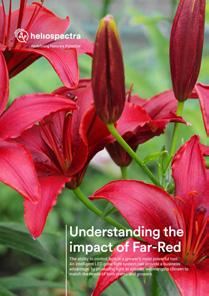





www.heliospectra.com
Specifications • Efficacy of up to 3.4 μmol/J • Reliable wireless control • IP66 rated • Wireless dimming • 5 years warranty • Spectrum: helioSPEC R40F Flex, helioSPEC R60F Flex, helioSPEC R80F Flex Scan our QR-code and get a free copy of our ebook
LED LIGHTS DAWN MASSIVELY ON HORTICULTURE
When Danish pot rose grower Rosa Danica invested in an LED lighting system earlier this year, plant quality and uniformity were improved so much that they were able to switch from planting three cuttings per pot, used under HPS-only lighting, to two cuttings under the new hybrid installation without compromising on the product’s appearance.
According to Paul van der Valk, international sales manager for Netherlands-based isupplier Hortilux Schréder: “The grower wanted to save energy but achieve the same light intensity as they were currently using.

“We worked with them on the design where for most of the time, the LEDs provide all the additional light at an optimum spectrum for each stage of the crop, with the HPS used only when needed for the darkest days in the winter.”
GOING STRAIGHT FOR LED ONLY
Energy costs may have seen some growers in regions such as southern Europe switch supplementary lights off for a while, but at the same
time, they have driven investment in energy-efficient LEDs in areas with lower natural light intensities. “Just four years ago, our sales were split evenly between HPS and LED: now it’s 90 per cent LED,” he says. He adds, “And while it has up to now been common for growers to start with a hybrid installation, more are now opting to go straight for LED only.”
HACKING THROUGH THE SUPPLIER JUNGLE
The acceleration in take-up of the technology, however, is seeing dozens of suppliers offering lighting to growers, which can make it confusing to pin down what best will suit your situation and crop. “With HPS, you had a choice between a couple of power outputs and a couple of
different reflectors, and that was about it,” says Mr. van der Valk.
“With LED this year, we alone offer seven different power outputs, seven standard spectra and three different lens optics to control light distribution ¬– that adds up to 147 options just from one company. It’s now much harder for growers to compare offers.”
While plenty of independent advice is available to help you, he believes only five lighting companies worldwide have enough of a track record in horticultural LED installations. “It’s one thing making lights for a home, office or warehouse and another for a greenhouse,” he says. “The greenhouse environment is very challenging with its high humidities, fluctuating temperatures and need for a high degree of controllability, let alone efficiency and reliability.”
FLORACULTURE INTERNATIONAL OCTOBER 2023 20 TECH
AUTHOR: SPENCE GUNN
Rosa Danica’s LED lighting system improved plant quality and uniformity to such an extent that it allowed them to switch from planting three cuttings per pot, used under HPS-only lighting, to two cuttings under the new hybrid installation without compromising the product’s appearance.
WHAT DOES THE CROP NEED?
The starting point for designing an installation has to be an understanding of what the crop needs, he says. “A crop under LEDs has to be grown in a totally different way, not just because of the difference in the light itself and the ability to tailor the spectrum, but because the lamps generate less heat. “That can be welcome for crops such as cut tulips, where the heat produced by HPS lamps often needs to be removed, but it also has an impact in areas such as humidity control. You’re not just swapping the source of light; the whole greenhouse climate has changed. “That’s why we, for example, are part of the Plant Empowerment Foundation [a Dutch association of various specialist horticultural supply companies and universities], so we can work with experts in other aspects of environmental management such as screening and humidity control.”
The big gains in LED energy efficiency achieved in the last decade or so, which have made this form of lighting so attractive as an investment, are unlikely to be repeated in the next few years, says Mr van der Valk. “In 2018, a light output of 2.8 micromoles per joule of energy was considered really good. Now we see 3.5, and the price [of a fixture] per micromole has dropped. In the next two to three years, efficiency might reach 4 micromoles per joule, depending on the spectrum. But higher efficiency is also more expensive because, for example, these lights will need better cooling.”

The new HORTILED Top Antares fixtures are highly versatile. Six different configurations are possible for power consumption, ranging from 520 to 1050 Watts. A dimming function allows growers to vary their energy input and thus adjust production to energy prices, the seasons, market demand and specific crop needs.

CONTROLLABILITY
More recent advances are all about controllability. He says: “The industry has already learned a lot about the light quality needed by different crops at different times of day, seasons, and growth stages. A key technical development now is controlling LED fixtures through dimming. With the latest digital dimming technology, you can precisely adjust light intensity depending on crop requirement; for example, young plants need a lower light intensity than a more mature crop.” With modern LED fixtures producing light from four different colour LED ‘chips’ – red, blue, green (or white) and far-red – the current emphasis is on being able to dim each one separately to adjust both light output and the colour balance. “It needs more development as it’s currently expensive, but the goal is to be able to steer a crop by light quality.” Switching several lamps off is the only way to control light intensity from an HPS installation. That will affect light distribution, which in turn can affect crop uniformity. “With dimmable LEDs, you dim each fixture equally, so you maintain uniform light distribution,” he says. Dimming also means the fixture runs cooler, increasing its efficiency. The next step is wireless control. “This involves creating a network that can be used for other crop data. So, for example, a fixture would ‘know’ when the bench underneath it is empty of the crop and would automatically be turned off. The network can also be easily integrated with the climate control and even be linked to pest and disease monitoring systems.”
LEDS IN ORCHIDS
When it comes to environmental management, orchids are probably among the most demanding of all crops. Their requirement for light intensity
and quality both vary, along with temperature, across the different growth phases over an 18-month production cycle.
Hortilux’s consultants worked with Ter Laak Orchids in the Netherlands for about three years to work out and trial the lighting strategy for an installation completed last year to largely replace the original HPS set-up.
“The company was looking for energy savings and greater controllability of not just the light environment but temperature as well, particularly during the cooling phase of production,” says Mr van der Valk. “Production is on benches that move through the different environments. We made an optimum light plan for each growing stage, including hybrid lighting for the stages where we needed to retain the heat from the HPS lamps.”
FLEXIBILITY VERSUS COST
With the degree of controllability now becoming available, there is a risk of over-complicating the operation for growers, admits Mr. van der Valk. “It’s a question of flexibility versus cost,” he says. “Many regimes are now possible, but the question is, will you really make use of them?
“For example, you can switch off the green LEDs in the fixtures when no workers are in the crop [green light is needed by workers to ‘see’ what they’re doing], so the energy is used to power the more efficient red LEDs. But the overall benefit might be worth just 5-10 euros per year per fixture, as even the green light is of some use to the plant. It’s a question of working out if the extra technology is justified.
“That’s why it’s so important to connect with a company that understands what the crops need and will work with you on trials to find the right solution,” he says.
WWW.FLORACULTUREINTERNATIONAL.COM 21 TECH
Paul van der Valk, international sales manager for Netherlands-based supplier Hortilux Schréder.
A STEP BEYOND JUST LIGHT
Heliospectra, a Swedish horticulture LED lighting solution provider, and AIPH Affiliate Member, explains how its smart LED lighting technology and precision growing maximise energy savings and plant growth.

AUTHOR: REBECCA NORDIN
Imagine a greenhouse where lighting adapts seamlessly to the needs of plants, optimising energy consumption without compromising growth. Heliospectra has turned this vision into reality with its high-quality LED lights, equipped with wireless dimming capabilities and integrated sensors, all managed through its innovative helioCORE software.
"Heliospectra's approach is rooted in creating a lighting strategy that is efficient, intelligent and adaptable," says Heliospectra’s Rebecca Nordin. The helioCORE software ensures
optimal plant growth by automatically adjusting and dimming LED lights based on factors such as natural light levels, fluctuating energy costs, and the efficacy of the light itself. By avoiding using the lights when not needed and prioritising the use of lamps when energy costs are at their lowest, growers can significantly reduce operational expenses.
EFFICIENCY MEETS INGENUITY
What sets this technology apart is its precision algorithms and ability to establish multiple grow zones within a greenhouse without the need for complex upgrades. Every five minutes,
the helioCORE DLI controller calculates the optimal light strategy throughout the day, considering DLI goals, energy prices, historical data, and accurate weather forecasts. This strategic zoning conserves energy and ensures that each plant receives the ideal amount of light for its growth stage.
Nordin emphasised that this ingenious approach can lead to energy savings of up to 30-35 per cent on top of the benefits derived from LED lighting, depending on the light goals and geographical location of the user.
SPECTRUM PRECISION
Heliospectra's journey in horticultural lighting spans over 17 years, during which they've meticulously explored the interplay between light and plants. Their commitment to precision is exemplified by their targeted spectrum portfolio and three levels of spectrum control. As part of their continuous innovation,
FLORACULTURE INTERNATIONAL SEPTEMBER 2023 22 OCTOBER 2023 TECH
Heliospectra introduced the Adelphi, a LoRA-based wireless connector facilitating true wireless dimming and control within greenhouse facilities. This technology saves money as growers avoid installation costs and wires while seamlessly integrating with the helioCORE software, allowing growers to set dynamic light integral (DLI) targets and zone-specific light strategies, all contributing to improved energy efficiency and crop quality.
Nordin highlighted that the gamechanger in floriculture lies in the flexibility of their far-red solutions, such as the MITRA X FLEX and CERES FLEX, combining three spectra in one (PAR, PAR + FR, and FR only) with wireless dimming. This enables growers to tailor lighting conditions to specific crop varieties or stages of growth, accelerating growth, boosting flower yield, and enhancing plant quality during periods of low natural light.
CUSTOMISATION AT THE GROWER’S FINGERTIPS
Nordin elaborated on the remarkable capabilities of helioCORE and precision growth, which allows growers to
divide their greenhouse into multiple ‘grow zones’ with customised lighting strategies. This dynamic feature optimises energy use while ensuring consistent growth throughout the greenhouse, adapting to seasonal changes and microclimates.
Zones by Bay, Zones by Climate, and Zones by Crops – these functionalities enable growers to tailor lighting strategies according to their greenhouse layout, microclimate conditions, and crop requirements. The intuitive user interface streamlines the process, allowing the growers to harness light as a precise tool for fostering optimal growth.
“By using a system that is flexible, allowing growers to create and change grow zones and groups easily, they can save a significant amount of money, not only with the use of the DLI controller and dimming down the lights but by simply being able to turn off bays that are not in use,” Nordin explains.
UNLOCKING HIDDEN REBATES
When commercial growers adopt LED lighting technology, they commonly seek subsidies and rebates, which can cover a substantial portion of their project
Heliospectra’s approach is rooted in creating an efficient, intelligent, and adaptable lighting strategy.
expenses—reaching as high as 40-50 per cent.
What's not widely recognised is that these growers can also avail themselves of extra rebates by implementing energy-saving solutions like helioCORE, subject to the specific rebate program. Consequently, employing an intelligent lighting system proves advantageous in terms of operational expenses and reducing the upfront capital required.
In conclusion, Heliospectra's nextgeneration LED lighting technology and control system stand as a testament to innovation, meeting the needs of modern floriculture while minimising the ecological footprint. The marriage of energy efficiency and plant growth optimisation is exemplified by wireless dimming, zoning strategies, and spectrum control functionalities. As the horticultural sector has embarked on a journey towards sustainable cultivation practices and heightened yields, Heliospectra's visionary solutions illuminate the path to a greener and more productive future in floriculture.

23 WWW.FLORACULTUREINTERNATIONAL.COM TECH
SILIC BOOST

SILICON REGULATES AND IMPROVES ABSORPTION OF NUTRITION

SILICON CREATES A STRONGER AND THICKER STEM
SILICON IMPROVES STRENGTH OF THE OUTER LAYER OF THE LEAFS AND STEM, ENHANCING THE PLANT’S RESISTANCE TO DISEASES AND STRESS

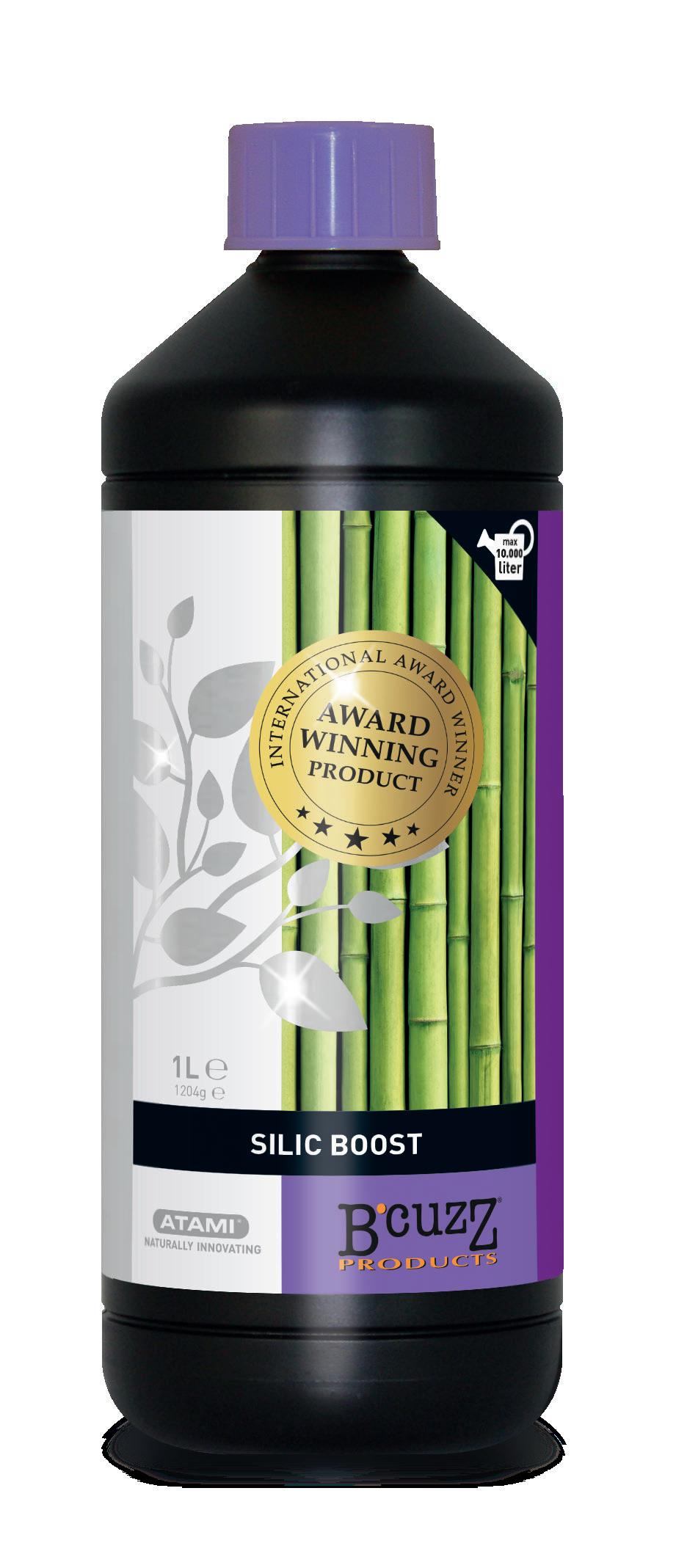

@atami.international
NO3 NO3 NO3 K K Ca Ca Ca Fe Fe Fe Mn Mn K Mn Si Si Si Si Si Si Si Si Si Si Si Si Si Si Si Si Si Si
Boost your plants’ strength with B'cuz z Silic Boost



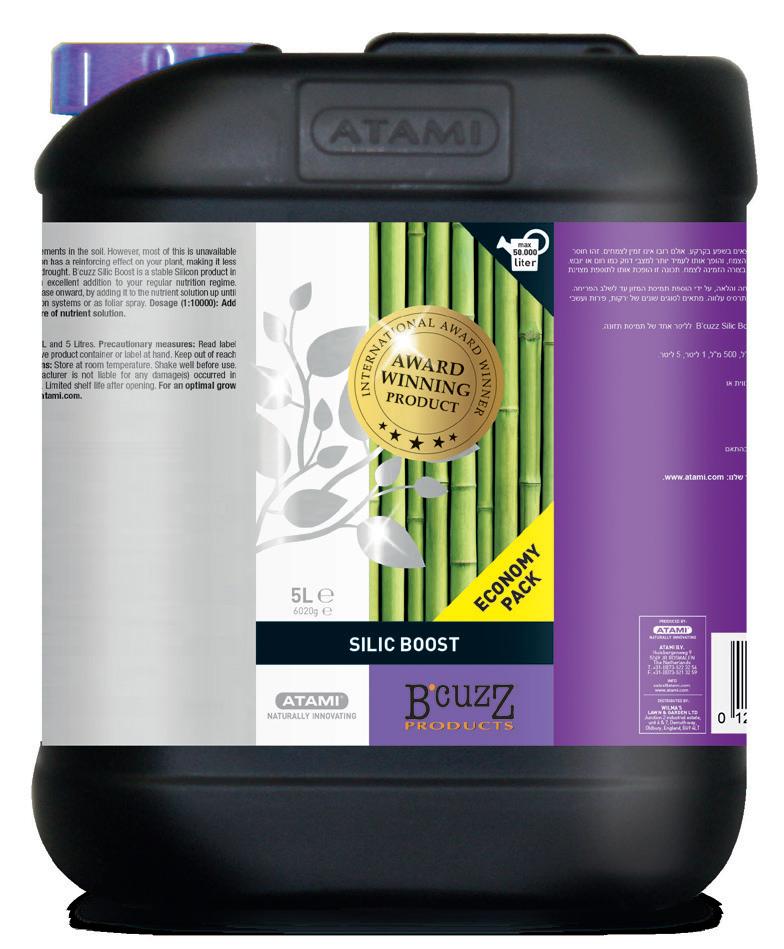
Silic Boost is a great addition to your regular nutrition, supporting and protecting your plants from the inside. Read on to find out how it works!
As the name suggests, the key ingredient in Silic Boost is Silicon. Maybe you didn't know much about this element, so let us shed some light on this. When taken up by the plant, the Silicon is deposited and accumulated in the outer layer of leaves, stems, flowers and fruits. This will strengthen and harden these structures, acting as a sort of shield and enhancing the overall resistance of the plant. But there is more; Silicon also regulates and improves the absorption of nutrients like potassium, which is important for plant development and blooming.
Unfortunately, plants cannot utilise most forms of silicon found in nature. But don’t worry! That's where Silic Boost comes into the equation. This Atami booster contains a lot of silicon that plants quickly assimilate. And, because Silic Boost is highly concentrated, adding just 0.1 ml per litre of water will make you notice the difference in just a few applications!
It doesn't matter what kind of gardener you are; Silic Boost is suitable for all types of crops, stages of plant and growing methods. Plus, it's really easy to combine with the rest of your plant nutrition.



In fewer words, you will see how Silic Boost can strengthen the overall health of your plants and support better nutrient absorption. All this is thanks to the silicon that helps the plants become more resistant and resilient!
With Silic Boost, your crops will be ready to face any challenge and give you the best harvests. Don't miss the opportunity to protect your plants from the inside with this innovative product.You will find more information on our website and social media; follow us there!
25
ADVERTORIAL WWW.FLORACULTUREINTERNATIONAL.COM
Want to know more? Visit atami.com, or check out our social media!
A dream for many gardeners is that their plants can better withstand difficult conditions, such as lack of water, strong winds or even light frosts... Believe us if we tell you that now you can achieve this with your plant nutrition. How? Giving your plants Silic Boost.
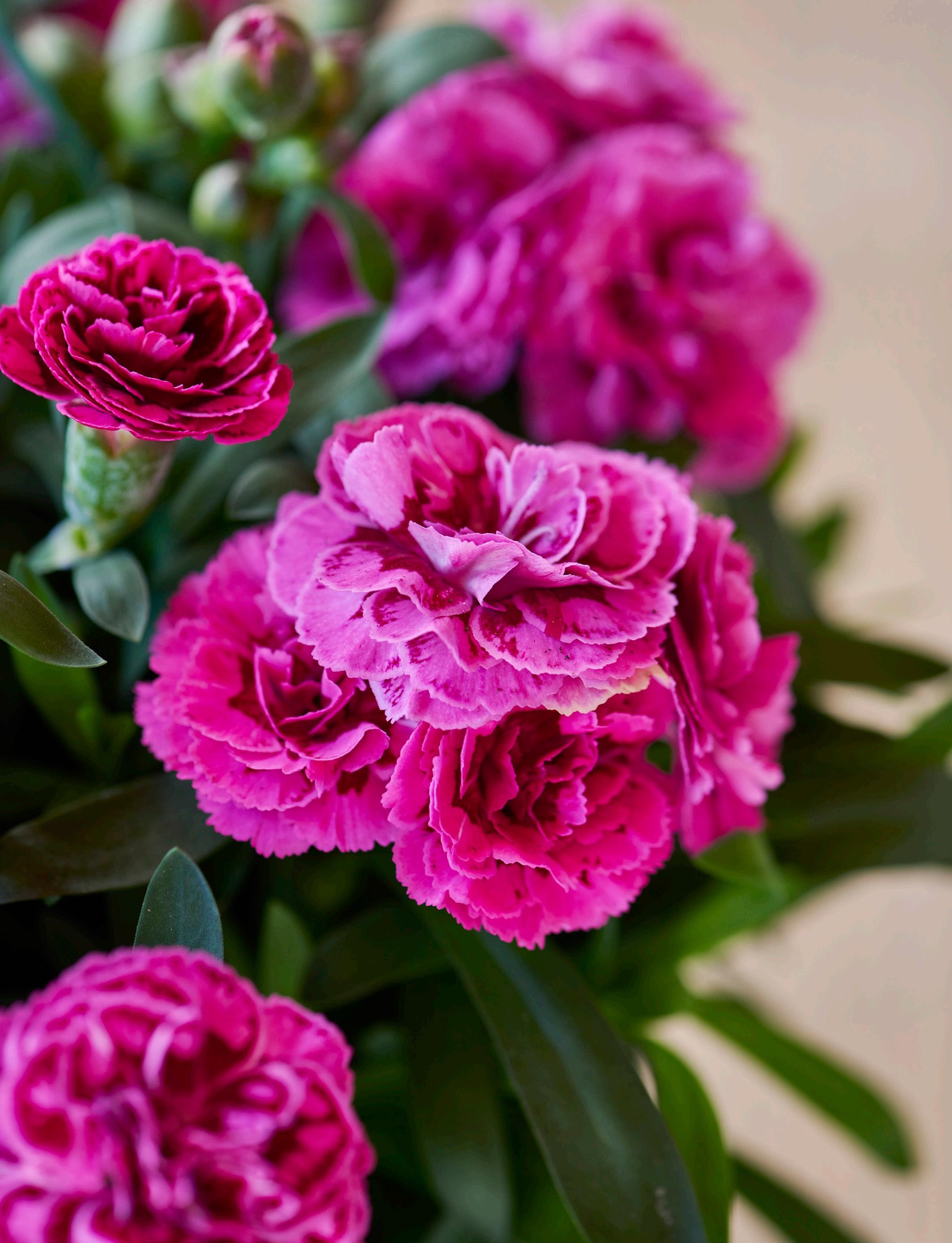
FLORACULTURE INTERNATIONAL OCTOBER 2023 26 SPRING BEDDING
HilverdaFlorist’s Dianthus Sunflor Sinclair.
STATE OF THE POT CARNATION
Thanks to innovative breeding and marketing, one of Europe’s oldest cultivated ornamentals has staged a comeback as the newest kid on the block. What lies behind the modern pot carnation’s storming of the industry over the last ten years? And what might the future hold for this growerfriendly, seductive product?
Native to the northern Mediterranean, the perennial border carnation (Dianthus caryophyllus) has been improved and selected by breeders for at least 500 years, but not until the 1970s were systematic efforts made to develop dwarf strains for the pot plant market in the US, Japan, and Europe.
Over recent decades, huge strides in interspecific breeding programmes (involving, e.g. D. barbatus and D. chinensis) have reinvented the pot carnation as a product that is as attractive to producers and retailers (for its predictability, low energy costs, and shelf-life) as to consumers (for vivid colours and long flowering). Trading volumes tell their own story: in 2022, Royal FloraHolland traded 21.6 million units, mainly to Germany, followed by France and the UK, as well as the Netherlands.
OUT OF AFRICA
A production process that allows for tight control of quality is key to the success of the modern pot carnation. Breeders such as Selecta One and HilverdaFlorist produce their cuttings in East Africa, where high insolation, cold nights and low humidity make for ideal growing conditions. Cuttings are then flown to rooting facilities in Europe before being sold to growers as rooted cuttings; at this point, most varieties can be grown without additional heat.
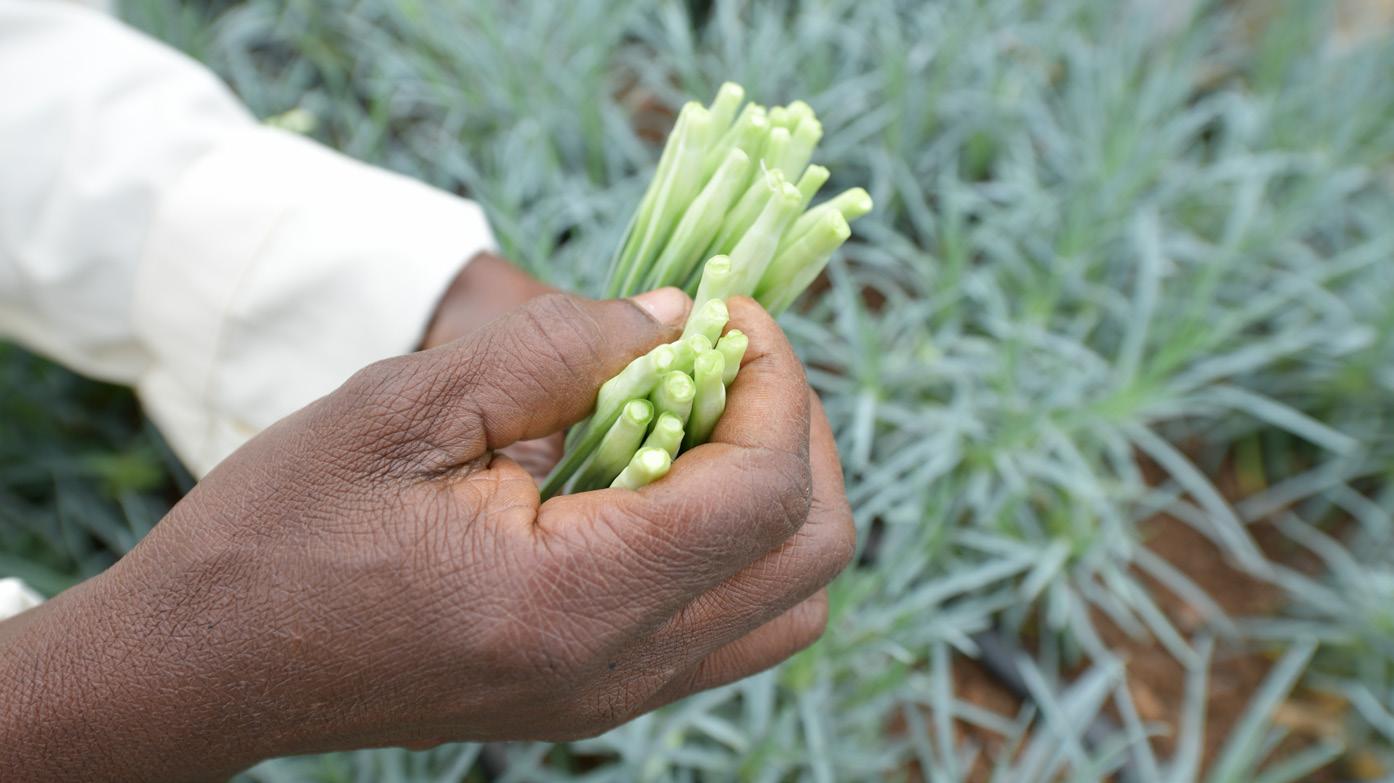
A significant driver in the huge expansion of the pot carnation market was producers’ realisation
that empty frost-free glasshouses could be used to grow a valuable crop with little input. The growing season is long: European producers can meet Valentine’s Day demand with early varieties such as Selecta’s ‘IU’, ‘Early Love’ and ‘Purple Wedding’, and plants are offered for sale until late October (weeks 8-42). Under ideal conditions and depending on variety, smaller pot carnations can be finished in as little as ten weeks.
VARIETY AND UNIFORMITY
Pot carnations vary in vigour and habit, from super-compact indoor varieties to highly vigorous types for outdoor pots, such as Selecta’s Capitán series.
A key development in the modern carnation industry was Selecta’s compact Oscar series—a sport-based series based on colour mutations selected from the same parent. The extreme homogeneity of the varieties in sport-based series simplifies and
streamlines production and opens creative possibilities, such as combining different colours in the same pot.
HilverdaFlorist offers four brands suitable for every market and cultivation programme: Beauties®, Flow®, Odessa® and Sunflor®. Each has its specific features and characteristics.
HilverdaFlorist’s Sunflor® was one of the first pot carnation series on the market. Since its merger with HilverdaKooij and Florist Holland in 2019, the company has worked to rationalise its carnation portfolio. One important development has been the creation of a distinct grouping within the Sunflor® brand, Sunflor® Selection, which groups together varieties chosen for uniformity and speed.
HilverdaFlorist also has its Odessa® series that offers extra tall varieties. This series consists of voluminous and floriferous plants with vigour and frilly flowers. Odessa® varieties can be handled in larger pot sizes and can grow up to 30 cm.
WWW.FLORACULTUREINTERNATIONAL.COM 27
AUTHOR: MARTIN DEASY PHOTOS: SELECTA ONE AND HILVERDAFLORIST
SPRING BEDDING
HilverdaFlorist’s Kericho-based cutting farm Murara Plants Ltd was among Kenya’s 2023 Energy Management Awards (EMA) winners.
From Maggiore’s to Grande’s and Medio’s to Piccolo’s, LaBella Dahlias come in all sizes and colours. For example, LaBella Dahlia Maggiore is a real eye-catcher with its extravagant and large flowers.
Are you already familiar with the ‘fun’ colours? These are distinguishable by the special colour combinations in the flowers.


The LaBella Dahlia series, with flowers that know how to highlight the art of nature, are all artists that suits every garden.
Order your LaBella Dahlia young plants or cuttings now!


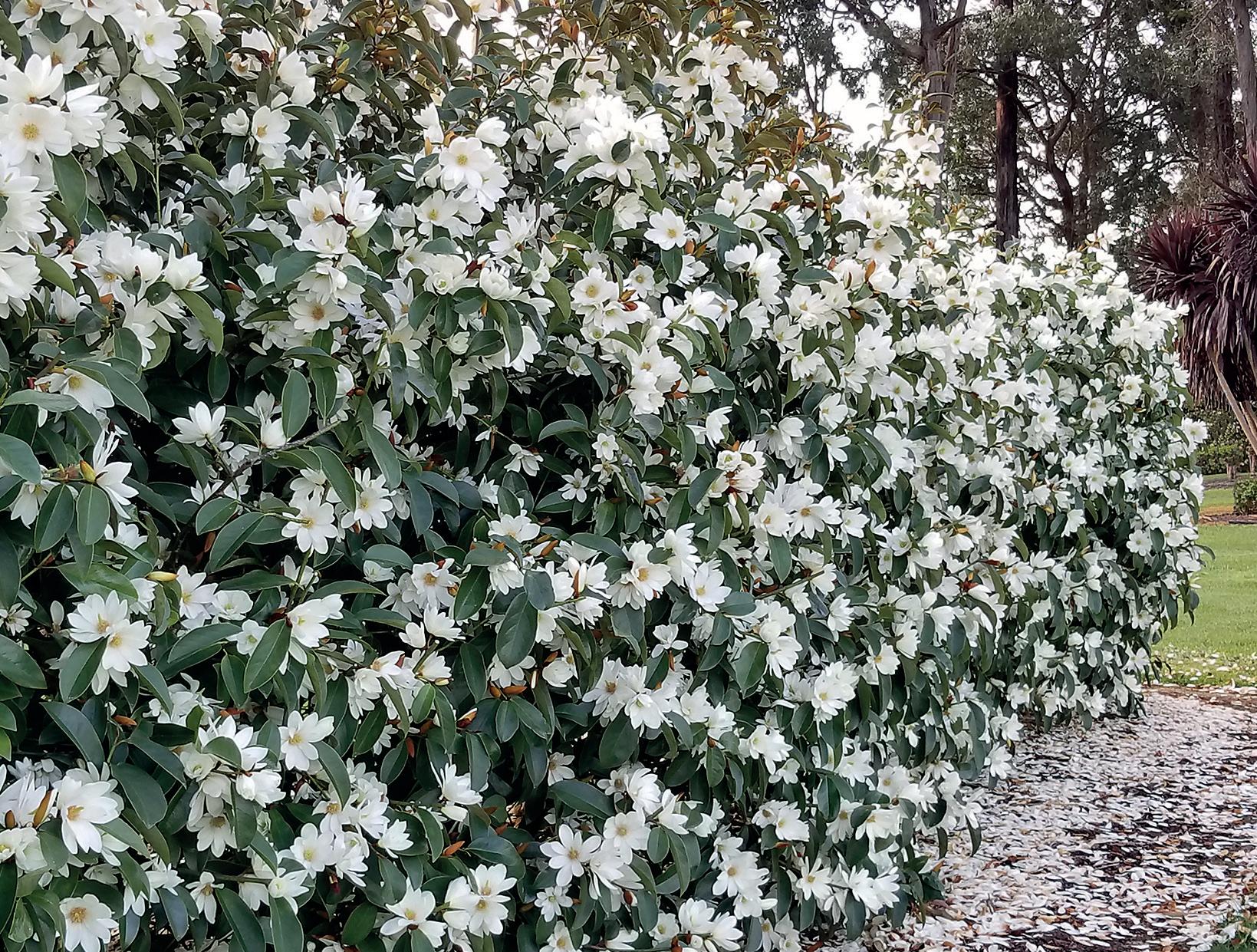
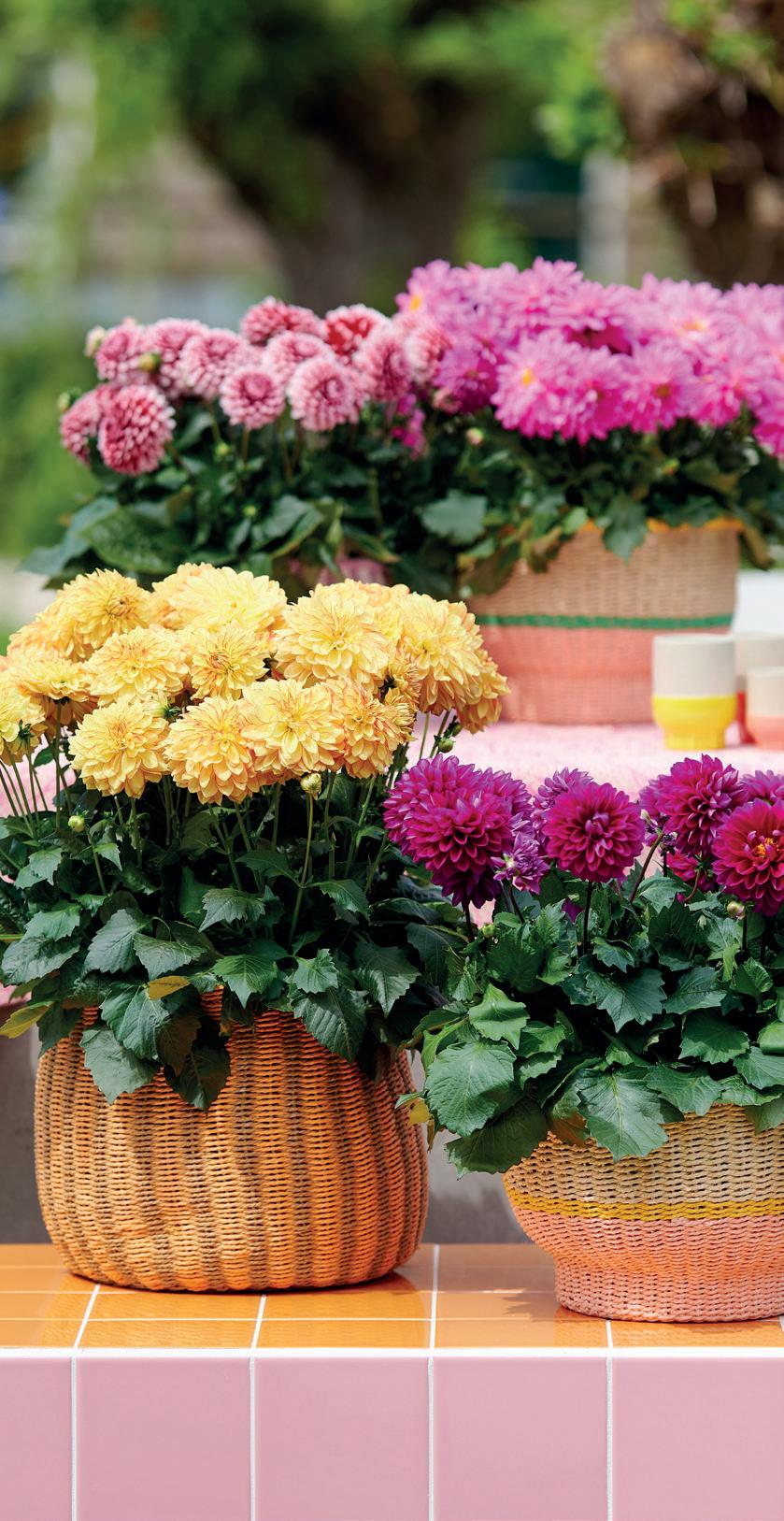
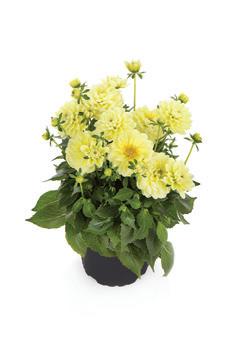
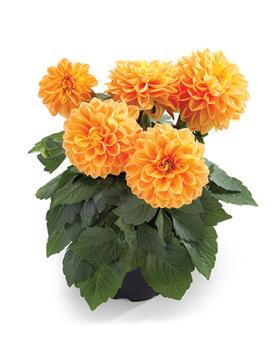
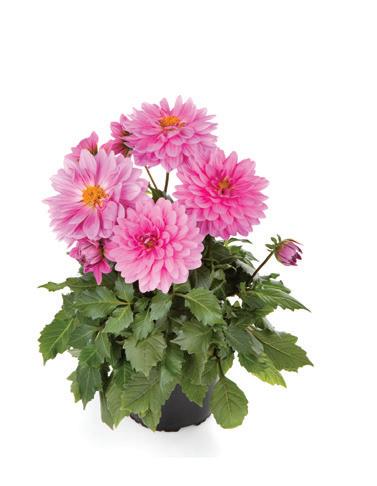

Pot size: 19-23 cm 8-10 inch
Pot size: 14-17 cm Gallon
Pot size: 12-13 cm Quart-5 inch
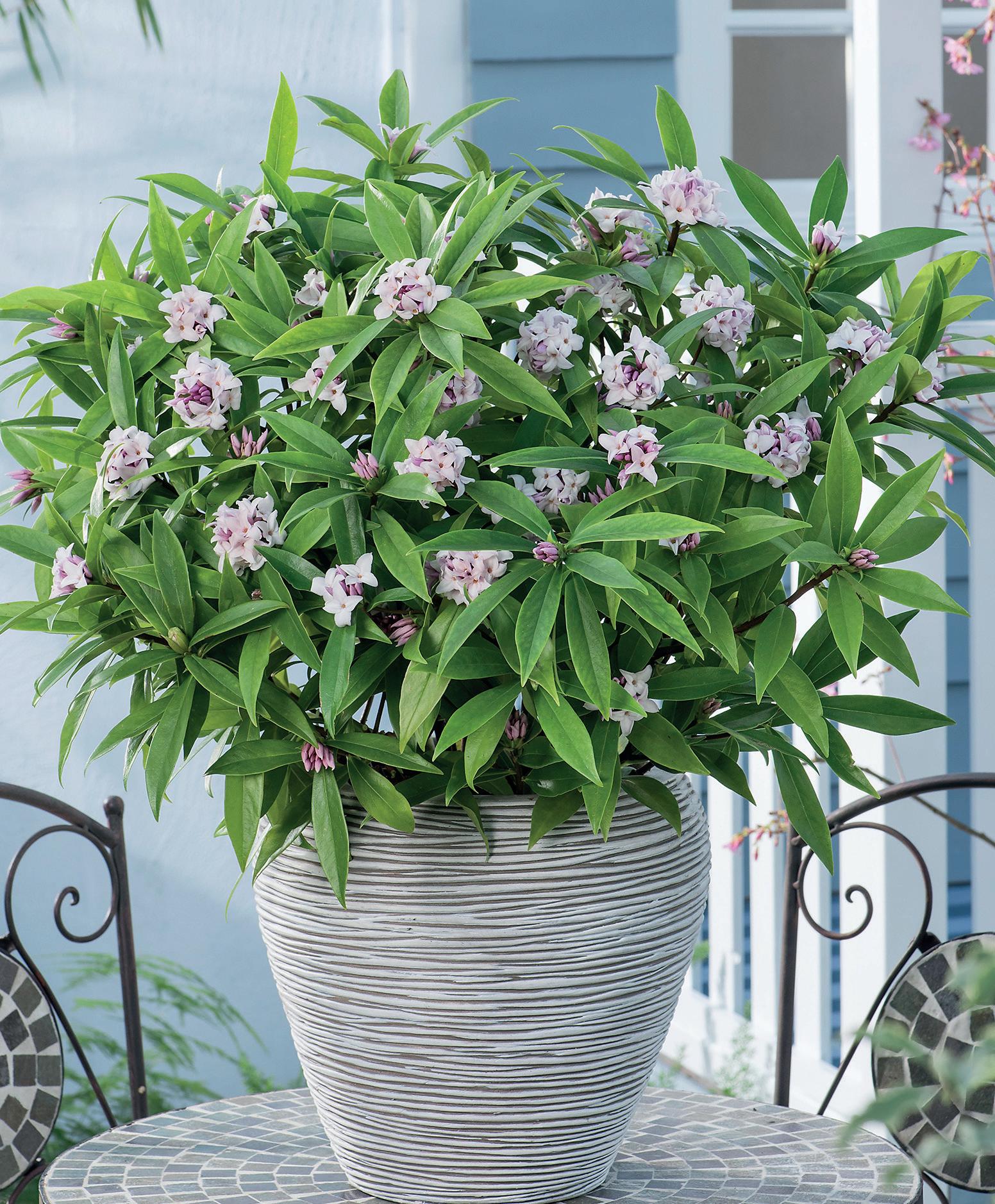
Pot size: 7-10,5 cm Quart-5 inch
 MAGGIORE GRANDE MEDIO PICCOLO
MAGGIORE GRANDE MEDIO PICCOLO
A stunning fragrant & flowering hedge www.tesselaar.com contactus@tesselaar.com For the entire range of distinctively different plants: Exotic perfume, longer flowering, breakthrough breeding
The company’s Dianthus® Beauties series comprises perennial Dianthus varieties which are easy to cultivate indoors with limited heat or even outdoors throughout autumn and winter.
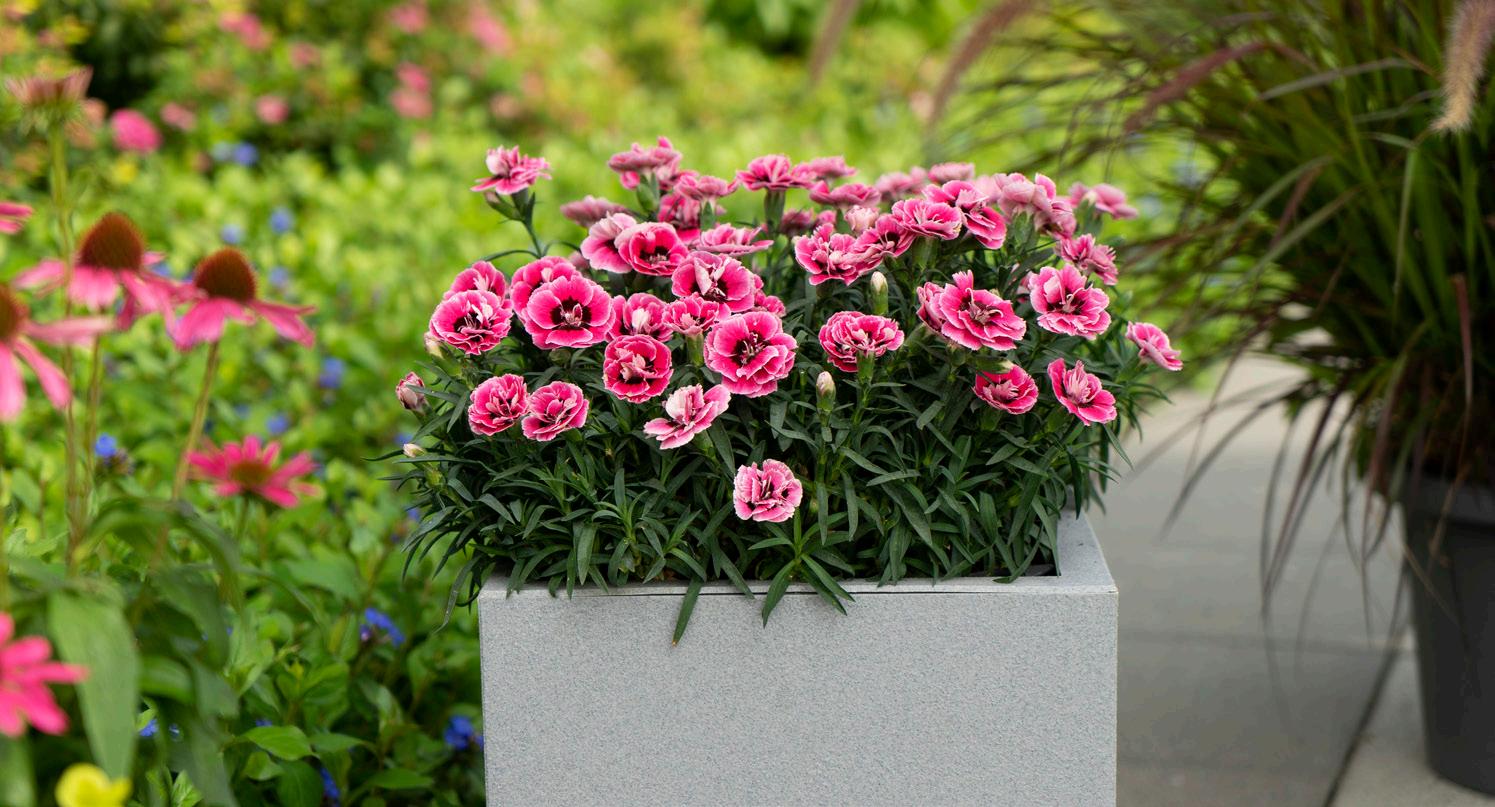
“Fast, compact, and rich flowering.
“Beauties® is our perennial Dianthus series, which delivers an excellent garden performance with great flower quality and cold- and rain resistance. Several varieties produce a delicate scent. These tough perennials are easy to grow, quick to finish and programmable for year-round sales,” says HilverdaFlorist’s Sjaak Sijm.
COMPACTNESS IS KEY
While larger carnation varieties suitable for bigger pot sizes (e.g. HilverdaFlorist’s Flow or Selecta’s SuperTrouper) remain popular, particularly in warmer regions, the modern success of the pot carnation lies largely in its compact aspects—robust and easily handled in distribution, highly adaptable in retail programmes.

Popular sizes in Northern Europe are typically 10.5cm or similar (80 per cent of the 6 million Pink Kisses grown annually by IJzelenberg plant nursery in Westland, Netherlands, are in 10.5cm pots).
The aim of pot and container use is always to produce a well-branched, sturdy, compact plant. Specific growing strategies vary according to cultivar and local conditions, but plants always require good light and prefer to grow cool and dry. Cool nights help to build compact plants, avoiding the need for plant growth regulators.
The evolving regulatory landscape continues to make demands on growers. The use of PGRs is increasingly restricted and seems likely to be phased out completely (at least for European production). The gradual phasing out of reliable and predictable peat substrates is another challenge, particularly with a water-sensitive crop.
THE FUTURE’S PINK
The reinvention of pot carnations as a distinctively modern product is seen in Selecta’s Gen Z-flavoured marketing programme for the Pink Kisses variety, its first campaign to
target consumers directly.
Beginning in 2017, this innovative campaign has deployed emotionbased marketing techniques to target a younger demographic using social and influencing platforms.
Richard Petri, marketing consultant and carnation expert, sees scope for much greater use of B2C marketing, noting that carnations’ long retail window opens up unique possibilities.
“Consumer marketing with most retail plants is very hard,” says Petri, “because the window to establish brand awareness is so narrow—only 6-8 weeks for bedding or poinsettias. Then, the
Pot carnations vary in vigour and habit, from super-compact indoor varieties to highly vigorous types for outdoor pots, such as Selecta’s Capitán series.
season’s over, and you have to start all over again next year.”
HilverdaFlorist’s Sunflor was one of the first pot carnation series on the market.
But carnation can be finished and sold for eight months of the year, giving plenty of time for a campaign to bed in. Continual advances in breeding look set to provide marketers plenty to work with in the future: besides extending the colour range and selecting for scent, novelties such as the striking YTT-style colour shifts in Pac Elsner’s distinctive ‘Solo Con Te’ and Selecta’s ‘IU’ indicate that there is still much that remains to be achieved in carnation genetics.
WWW.FLORACULTUREINTERNATIONAL.COM 29
Green City Post
GREEN CITY DEVELOPMENTS FROM AROUND THE WORLD
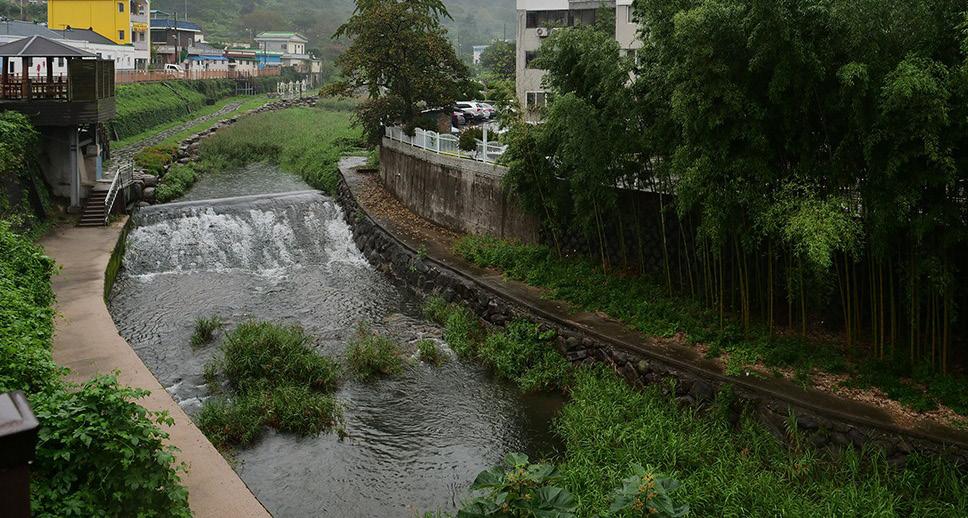
The 2023 AIPH Green City conference was held in Suncheon on 20 September as part of the 75th AIPH Annual Congress. AIPH welcomed three speakers to present the initiatives that the ornamental horticulture industry is involved with to increase the quality and quantity of greening in cities. In Canada, Australia, and the Netherlands, the exact needs for urban greening are recognised, and each country has programmes that discover and deliver solutions.
The Canadian Green City Foundation was established in 2018 by the Canadian Nursery Landscape Association (CNLA) with a vision to protect, nurture and grow urban green spaces for the health and well-being of all. Mr Bill Hardy explained how it is a private foundation with a mission to connect plants and people for a greener, healthier urban climate. Through collaboration with donors and volunteers, the foundation has already created a reserve of $200,000 for new projects after only five years of activity.
The Green City Foundation (www.gcfoundation.ca) describes the completed or underway projects, ranging from a hospital garden, a community garden, and a pollinator park. The website clearly outlines ways to support the foundation, including donating,
holding fundraising events, and volunteering. The Green Cities Foundation invites Canadian community volunteers to apply to the #GreenMyCity programme to support their project every year. Community gardens, businesses, service clubs, foundations, clubs, associations, and youth groups are encouraged to apply. Any publicly owned land contributing more productively to the community’s overall health and well-being may be eligible for restoration or revitalisation. The Green City Foundation aims to help communities create or improve green spaces that people can enjoy and improve air, soil, and water quality and the quality of life. The ornamental horticulture industry in the Netherlands established the Dutch Green City Foundation 20 years ago with the support of the Dutch government. Mr Albert Haasnoot related that the
FLORACULTURE INTERNATIONA L OCTOBER 2023 30
AUTHOR: DR AUDREY TIMM
The 75th AIPH Annual Congress on a tour of Jeojeon village in Suncheon, Republic of Korea, where urban greening has transformed the area.
industry was concerned that the benefits of trees and plants in providing solutions to world challenges were under-recognised. This multi-programme initiative has two aims: to demonstrate that the positive effect of greenery is measurable through scientific research and education to inform many target groups about these effects. Currently, 25 scientific studies are underway that respond to the needs of businesses, healthcare, industry organisations, education, government, and producers. Through this research, the added value of greenspace around, on and inside buildings can be quantified and reported. The findings are particularly important to the real estate sector because greening creates higher humidity and higher thermal comfort, makes places more attractive, and results in better moods for office workers and residents. All of this, in turn, results in greater job satisfaction and less absence due to illness, both of which deliver measurable returns to the value of office space. The Dutch Green City Foundation has many activities that share this knowledge, including their events, social media, participation in trade fairs and conferences, and the publication of fact sheets (www.degroenestad.nl / factsheets)
Following the success of the 202020 programme in Australia, the Green Cities Frontier Fund has been established. The 202020 Vision was a cross-sector, multi-stakeholder initiative, said Mr Glenn Fenton, that was designed to build the support, collaboration, inspiration, tools and framework needed to make Australian urban areas 20% greener by 2020. The Green Cities Frontier Fund (www.horticulture.com . au/hort-innovation/our-work/hort-frontiers-strategicpartnership-initiative/green-cities-fund) builds on the heightened awareness of the urgent need for urban greening to drive investment in strategic longer-term research, leading to a measurable increase in urban green space. This will earn Australia a global reputation as a country committed to urban greening and enhance the country’s reputation of being an excellent place to live, work, and do business. The programme engages Australian communities, asset managers, horticulture industries, and local councils, and the Australian government has four investment themes: Climate and environment, Metrics and measurement, Culture and community, and Knowledge and Transfer. Setting priorities, strategies, and actions for each theme, the anticipated investment outcomes for the Green Cities Frontier Fund are liveable, resilient, and green urban spaces for Australian communities supported by a prepared horticultural sector. These presentations show only a small sample of the work that AIPH members worldwide are initiating and undertaking to create greener, more liveable cities. AIPH is a hub for sharing inspirational projects and progress in global urban greening. To read more, sign up to receive the AIPH Global Green City Update (www.aiph.org/green-city/global-green-city-update/)
KNIPHOFIA (TORCH LILY)
Martin Deasy is a UK-based horticulturist and landscape designer.
Glowing inflorescences of Kniphofia hovering above the foliage layer of perennial plantings are a striking and dramatic effect available to the urban designer. Besides their vivid blooms in a range of colours from red-orange to yellow-green, Kniphofias’ great value in city plantings lies in the robustness of their flowering stems at a variety of heights. No other perennial with emergent flower scapes is so resistant to strong winds and knocks, sturdy enough to be used even in narrow ribbon-type plantings alongside sidewalks and roads
Most of the genus’s c.70 species grow in South Africa. Of most interest to temperate specifiers are the hardy species from the mountains of the Eastern Cape, including the late-flowering K. bruceae, K. caulescens, K. linearifolia, and K. rooperi
Hybridisation is common even in the wild, and the complex parentage of the 900+ cultivars mean that traits such as hardiness and flowering period are difficult to predict from appearance—a challenge, but also an opportunity for innovation.
Adapted to high summer rainfall and cold, dry winters, the hardy species cope well with drought (thanks to the rhizome and fleshy roots) and, in many cases, seasonal inundation.
Kniphofias’ performance in traditional garden border cultivation has earned them a well-deserved reputation for disliking winter wet, but the sharp drainage of engineered urban soils may significantly improve their chances of weathering freezing European conditions.

Some species (e.g. K. caulescens) actually favour poorly drained sumps and bogs, and in Northern England, the cultivars 'Percy's Pride' and 'Tawny King' are included in the semi-wet perennial specification for Sheffield City Council’s influential “Grey to Green” SUDS retrofit.
Adapted to high-altitude grassland, Kniphofias associate well with ornamental grasses. A long flowering succession is possible using different hardy varieties, from the short K. hirsuta ‘Fire Dance’, through to the appropriately named K. ‘Christmas Cheer’.
PLANT PROFILE WWW.FLORACULTUREINTERNATIONAL.COM 31
.”
Visit
PROFLORA IS 30
The first edition of Proflora, the Colombian flower tradeshow, occurred in 1991. Celebrations for the 30th anniversary had to be put on hold two years ago when the show had to be cancelled due to the COVID-19 pandemic, but it will happen this year at Proflora’23, between 4-6 October in Bogotá. FCI sat down with Cristina Uricoechea, who has been organising all 30 editions, to reminisce on the history of this show.
FloraCulture International: How did it all start?

Cristina Urichoechea: “Entering into the 1990s, floriculture in Colombia had become very successful. However, it was still a new industry needing support on various fronts. Asocolflores, the Colombian Association of Flower Exporters, was thus looking for ways to offer high-quality technical assistance to its members and encourage research. International advisors were regularly invited, and courses and workshops were organised with great success, calling the attention of services and supplies providers, breeders and others wanting to take advantage of events that brought together their target audience. In 1990, Jorge Enrique Uribe, then president of Asocolflores, thought interaction and information exchange amongst flower exporters needed a boost. So, he considered organising an event where they could showcase their products and services and share experiences at a local hotel. His idea was strengthened by a proposal from growers located north of Bogotá led by Gonzalo Maldonado of TAG - a flower company that no longer
exists - to organise a commercial gathering where they could interact with suppliers of interest for their region.”
It must be challenging - am I right?
“Initially, the Board of Directors at Asocolflores hotly debated these ideas. Some members did not agree that such gatherings were needed and argued that it was not the role of Asocolflores to intervene in marketing topics. A suggestion was made that if held, such events should happen, for example, in Miami, USA, where the bulk of flower buyers were located. In the end, consensus was found to organise an event primarily promoting a positive image of Colombian floriculture locally and internationally. The underlying thought was also to counteract the image of narcoterrorism. So, in 1991, the first Proflora was born. Mr. Uribe called on Monica Herrera, who had experience with the flower market, to organise, and she, in turn, called me. Monica moved on to other undertakings, but I am still in charge of the show’s overall organisation.”

FLORACULTURE INTERNATIONAL OCTOBER 2023 32
at Proflora to learn about our magazine or discuss AIPH membership
2606.
AIPH/FCI
with Senior Relationship Manager Treve Evans at Stand
EXPO-SURE
AUTHOR: MARTA PIZANO
Proflora organiser for 30 years, Cristina Urichoechea.
How did Proflora’s inaugural edition turn out?
“It seemed like a fantastic job, but we encountered tremendous hurdles once we started with the organisation. First, they couldn’t find a suitable place to hold the tradeshow. Corferias, Bogotá’s international business and exhibition centre where the Proflora is currently held, was prohibitively expensive and did not have the required infrastructure; they looked everywhere for suitable and affordable exhibition grounds to no avail; finally, Gonzalo Maldonado suggested the Holstein Coliseum, North of Bogotá, which made an offer they could work with. Finding a company to set up the booths, set up the banners and organise the exhibition grounds was nearly impossible. It took a lot of effort, and finally, we came across one company, Interexpo, who gladly accepted the challenge. And a challenge it was indeed; being a cattle exhibition facility, the ground was covered with sawdust, which invariably landed on flower petals as people walked by the booths, and obviously, there were no cold rooms to keep the flowers in. Proflora 91 was a great success: 161 exhibitors, including the 30 largest Colombian exporters, 68 providers of services and supplies and 23 breeders, plus 12,000 visitors, many of which were international.”
What happened next?
“From then on, Proflora has occurred every two years; as soon as 1993, it had moved to
Corferias, where the following three versions took place. These were, however, difficult times for Colombia, marked with violence and insecurity, and international buyers and visitors were becoming increasingly hesitant to attend the show. In a smart move, in 2001, for its 10th anniversary, Asocolflores decided to move the show to Cartagena, the lovely colonial city on the Colombian Caribbean coast.”
The hot, humid weather and the distance from the flower farms in Bogotá and Medellín posed new challenges.

“To top things even further, a few weeks before the opening, the September 11 attacks happened, and the show was nearly cancelled; support from Peter Moran at the Society of American Florists and other key persons in the industry around the world, was instrumental in pulling the event through. Cartagena was a resounding success and, until 2007, was host city to Proflora. It saved the show, maintained and increased the presence of Colombian floriculture in the international scenario and brought good income to the city. Despite all the complications arising from having to fly everything in –from flowers to staff, to supplies, services and whatnot- to keeping the exhibition grounds very cold, assisting visitors with logistics and many other details, things turned out great. Networking was superb, and business flourished. And everyone had a fantastic time.”
In 2009, Proflora moved back to Bogotá; why was that?
“By 2007, exhibition space was increasingly tight, and exhibitors found it increasingly difficult and costly to participate, more so because clients wanted to visit the farms, which added logistically complicated pre- and post-show activities. Colombia's security improved greatly, and the country’s reputation improved. So, in 2009, Proflora moved back to Bogotá; it was attended by 334 exhibitors spanning over 15,000 m2 of exhibition space in Corferias. Since then, it has not moved venues; it has become a one-stop-shop for
traditional and new buyers, flower exporters and many suppliers of goods and services. In addition, it provides great opportunities to tour production grounds with customers, explore new market opportunities, and even provide education and entertainment.”
What do you feel is the biggest strength of Proflora right now?
“It has become the most important flower show in Latin America; exhibitor and attendee figures increase every edition, and they come from all corners of the world. It remains a 100 per cent Colombian show, organised by Asocolflores; in fact, it is currently one of the largest assets of the association. Competitors have tried to seize the commercial opportunity in various ways but have not succeeded. There is an agreement with Ecuador to hold shows on alternate years to avoid shows running in parallel.”
What do you expect from the show’s 30th anniversary celebration?
“2021 was, strictly speaking, our 30th year, and since a celebration was impossible, we will be celebrating in style this year. The show is officially sold out, even though they increased the exhibition area by 10 per cent. Exhibitors from 18 countries around the globe have confirmed booth space, and visitor registration rises every day.
In celebrating 30 years, various great activities are planned for Proflora 23. Farm visits for buyers, press and others are being prepared with extra care. Visitors will see not just flowers but social and environmental programmes, harvesting, grading, packing, and, in short, the value chain. The Outstanding Variety Competition will comprise one category for growers and another for breeders; an international jury is being put together for the occasion. Exhibitors can also enter the Best Stand Competition, where decorations and displays will be judged. And last but not least, the show will end with the traditional fantastic party gathering more than 2,000 people at the magical Andrés Carne de Res restaurant.”
RUBRIEK WWW.FLORACULTUREINTERNATIONAL.COM 33
EXPO-SURE
OCTOBER 2023
2 OCTOBER 2023-
28 MARCH 2024. QATAR
AIPH-approved A Category
World Horticultural Expo 2023 in Doha Qatar. www.dohaexpo2023.gov.qa
2-4. ECUADOR
Hosted by HPP, Agriflor 2023 is an international floricultural trade exhibition taking place at the Centro de Convenciones Metropolitano in Quito. www.hppexhibitions.com
4-6. COLOMBIA
30th edition of the biennial Proflora show, at Bogotá’s Corferias Convention Centre. www.proflora.org.co
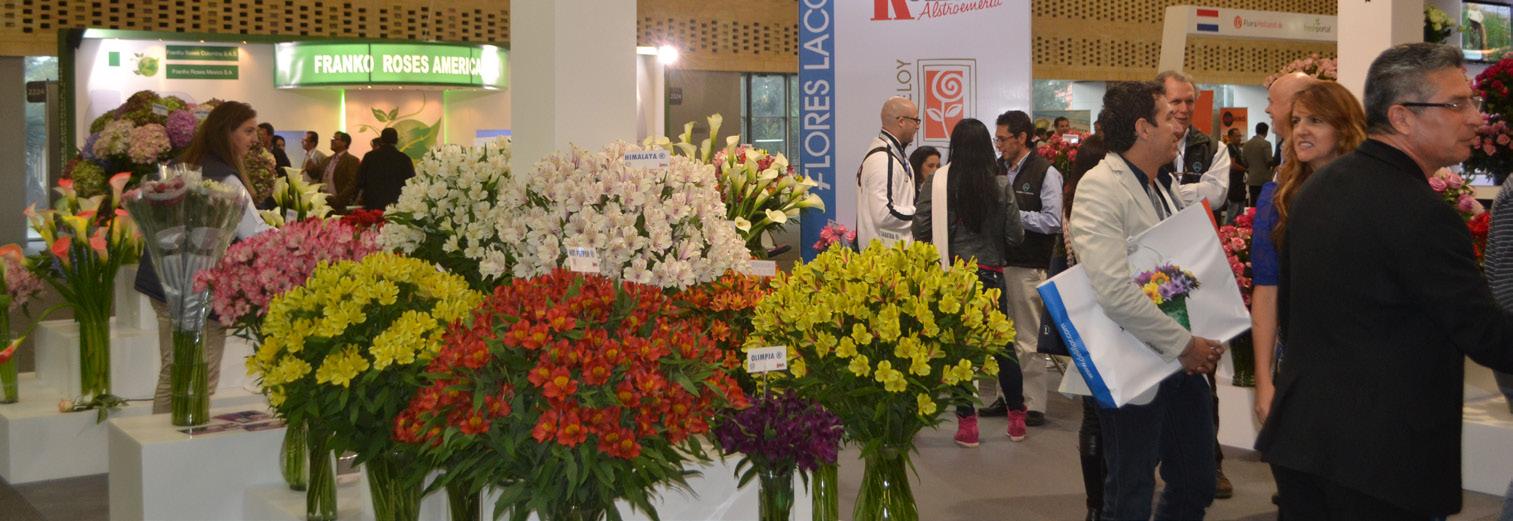
4-6. NETHERLANDS
GrootGroenPlus at Zundert’s CLTV Building. www.grootgroenplus.nl
23-25. SWITZERLAND
18th ABIM conference taking place at Basel’s congress centre. www.abim.ch
NOVEMBER 2023
8-10. NETHERLANDS
Trade Fair Aalsmeer at Royal FloraHolland Aalsmeer. www.tradefairaalsmeer. royalfloraholland.com
8-10. NETHERLANDS
International Floriculture Trade Fair (IFTF) at Expo Greater Amsterdam in Vijfhuizen. www.hppexhibitions.com/iftf
16-18. TÜRKIYE
Landscape Istanbul Fair (LIF) at the Istanbul Fair Centre. www.peyzajistanbulfuari.com
17. PORTUGAL
‘More Green Cities for Europe’ themed conference in Santarém’s CNEMA convention centre. www.apppfn.pt
23-25. POLAND
‘Gardenia an international trade exhibition for the gardening, landscaping, nursery stock and flower and houseplant industry. www.targigardenia.pl
COLOMBIA
Anticipation is building for 2023 Proflora show
Colombia’s premier international flower trade show, Proflora, is back for its first in-person event in four years at the Corferias convention centre in Bogotá between 4-6 October 2023. Visitors are encouraged to register now at Registration – Proflora to enter the show swiftly and make the most of everything on offer.
The excitement surrounding Proflora’s return is palpable, with the exhibition hall completely sold out. Flower growers and breeders represent 80 per cent of the area, and the remaining 20 per cent is dedicated to suppliers and service providers. From more than 18 countries worldwide, these industry leaders will present their latest products, innovative solutions, and cutting-edge technologies.
With over 7,000 professional visitors and buyers expected to attend from more than 60 countries, Proflora 2023 is set to be an international gathering of unprecedented scale. Attendees will see the diversity of flowers and foliage, showcasing an exquisite tapestry of colours, shapes, and scents. Everyone from industry veterans to emerging businesses will find opportunities to establish new connections, forge partnerships, and expand their horizons.
Proflora is not just a trade show; it catalyses new business opportunities and the continuous development of the global floriculture industry. The event fosters an environment
DECEMBER 2023
5-7. FRANCE
Paysalia, landscape, garden and sports exhibition at Eurexpo Lyon. www.paysalia.com
JANUARY 2024
16-18. FRANCE
36th edition of SIVAL, France’s
where professionals can exchange ideas, learn about best practices, and explore social, environmental, and economic initiatives inspired by the beauty of flowers. The agenda is brimming with engaging activities, including visits to flower farms, the prestigious Outstanding Variety Competition, an awards ceremony, and culminating with an unforgettable closing party celebrating the 30th anniversary of Proflora.
The show organisers are thrilled to announce the return of Proflora, which they tout as ‘the most amazing flower trade show in the world’. They stress that Proflora is not just a platform to showcase the finest flowers and innovative products but a celebration of the industry’s accomplishments and a testament to its bright future.
For more information, visit www.proflora.org.co
iconic agricultural trade show at the Parc des Expositions in Angers. www.sival-angers.com
17-19. USA
TPIE, the Tropical Plant International Expo at the Broward County Convention Centre in Ft. Lauderdale. www.tpie.org
19-28. GERMANY
Grüne Woche, international green week Berlin. The world’s largest consumer and trade fair for food, agriculture and horticulture.
www.gruenewoche.de
23-26. GERMANY
IPM Essen at Messe Essen. www.ipm-essen.de
FLORACULTURE INTERNATIONAL OCTOBER 2023 34
Visit AIPH/FCI at Proflora to learn about our magazine or discuss AIPH membership with Senior Relationship Manager Treve Evans at Stand 2606. SAVE THE DATE
OUR HEART BEATS GREEN
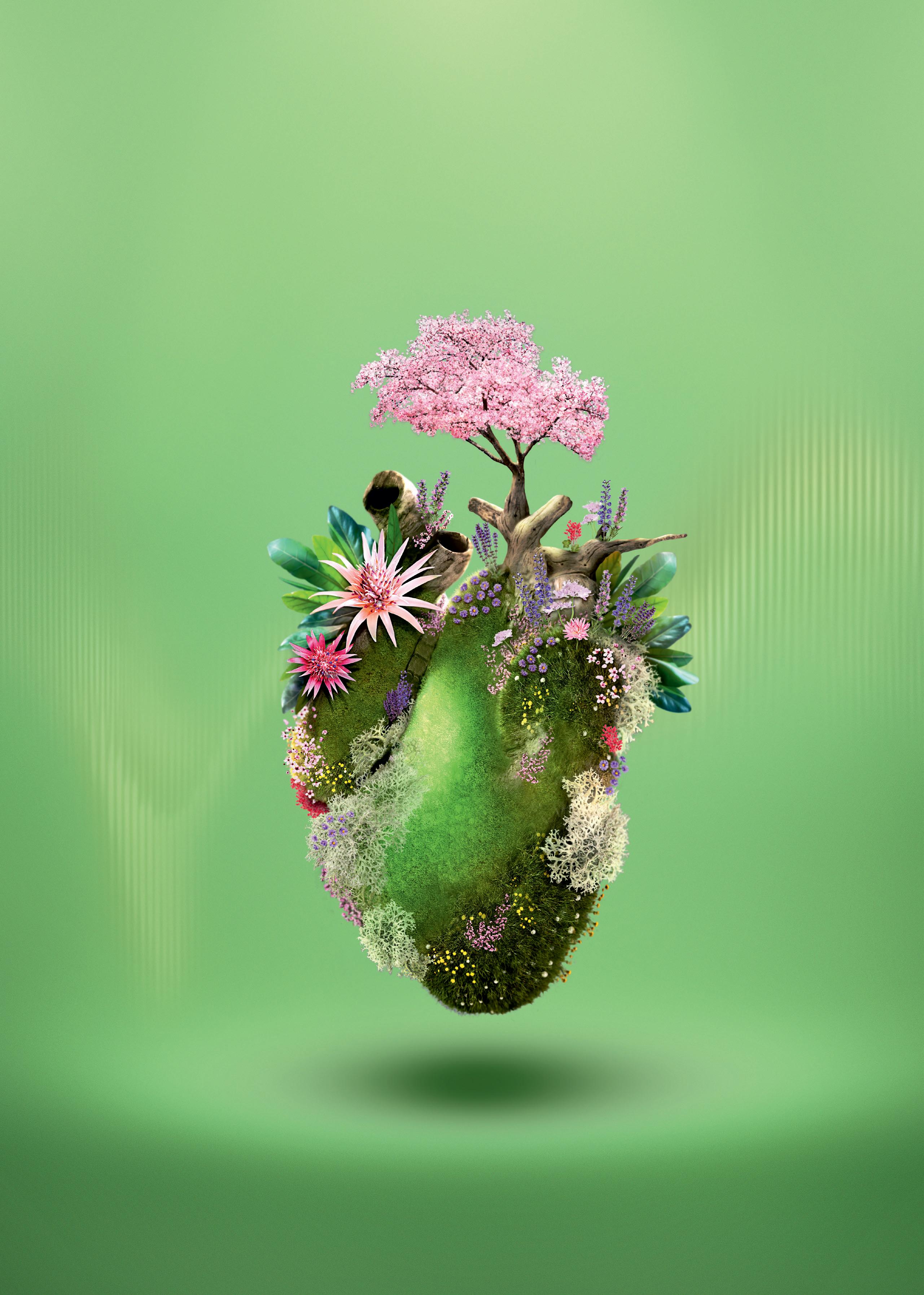
Each year, IPM ESSEN brings the international green industry together with enthusiasm and passion, looking to the future as a leading innovation driver. The remarkable array of plants and plant novelties, cutting-edge technical advancements, captivating floristic trends and garden features make IPM ESSEN the global source of green inspiration. Meet the green family!
PLANTS

TECHNOLOGY
FLORISTRY GARDEN FEATURES

23 – 26 JANUARY
#ipmessen #weareipmes sen #congratsipmessen WWW.IPM-ESSEN.DE
AIPH 75TH ANNUAL CONGRESS
The International Association of Horticultural Producers (AIPH) held its Horticultural Industry Conference on September 19, 2023, in Suncheon, Republic of Korea, as part of the AIPH 75th Annual Congress. The conference began with a focus on the ornamental industry in Korea and involved presentations from local researchers, associations, and producers. There was also an insightful presentation from the Dutch Embassy in Korea. In the afternoon, the conference shifted its focus to environmental footprinting, including the FloriPEFCR certification.
Over the past twenty years, the ornamental horticulture industry in the Republic of Korea has been in decline. Korean industry professionals offered their insights into why this is in the morning session of AIPH's Industry Conference, held on 19 September 2023 in Suncheon, Republic of Korea as part of the 75th AIPH Annual Congress.
Dr. Park Kihwan, Research Director at the Korea Rural Economic Institute (KREI), presented an overview of the ornamental horticulture industry in the

Republic of Korea over the past couple of decades. In 2005, there was peak in the industry in Korea. Park noted: “In 1990, the sales revenue was 239.3 billion Korean won. By 2005, it grew significantly to 1.105 trillion Korean won, indicating a growth of approximately 400%. However, in 2021, it decreased to 538.2 billion Korean won.”
WHY HAS THE INDUSTRY DECLINED IN KOREA?
Mr. Lim Yuktaek, President of the Korea Florist Association (KFA) and Korea Federation of Flower-Related Associations (KOFLAS) attributed it to the public opinion on ornamental flowers. He commented: “Flowers are still perceived as a luxury expenditure.” Typically, flowers are bought for events, such as weddings, and not seen as a day-to-day purchase. Lim continued: “Recent economic downturns have also led to a reduction in consumer spending.” In order to combat the industry’s decline, the Korean government has initiated several programmes to support growers and change
public opinion. Park commented: “In order to maintain the industry in the future the government established a consultation body for the floriculture industry. They plan to provide subsidies for growers who need to invest in their infrastructure.”
Other methods of supporting the industry include improving distribution systems, such as introducing electronic flower auctions, improving transparency in the imported wholesale market, and generating consumer demands for flowers.
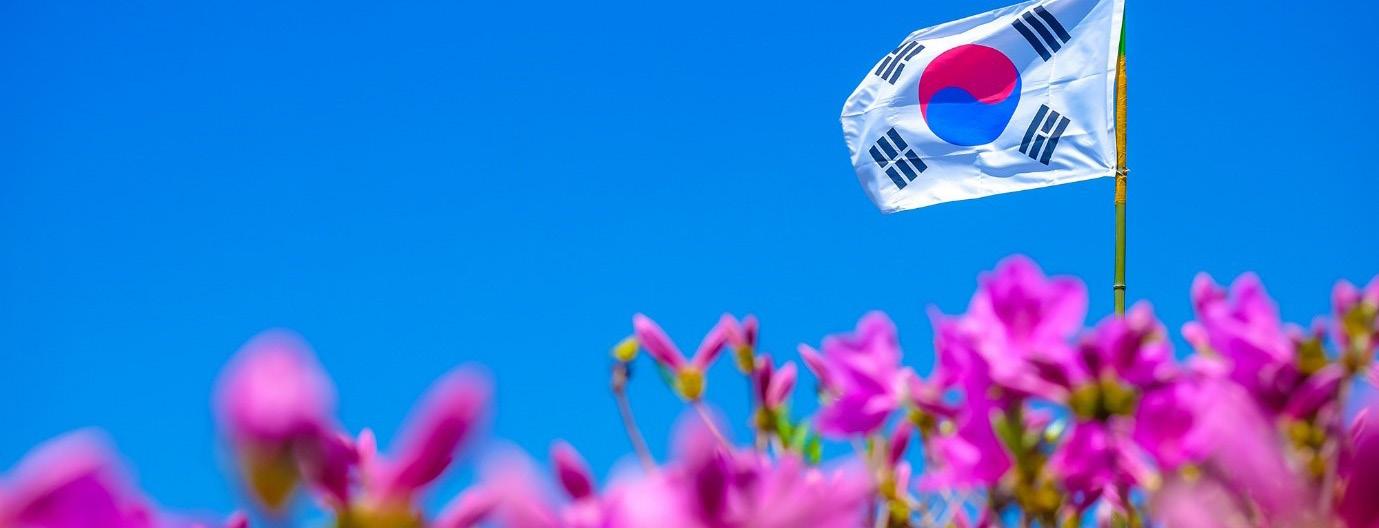
AN AGEING INDUSTRY
Another challenge for the Korean floriculture industry is the lack of young growers. From 2000 to 2020, there was a 46% reduction in the number of growers as younger generations choose not to follow in their parents footsteps. In order to combat this, the government has several strategies in place. One such strategy is to provide young farmers who are starting flower cultivation with leased farms equipped with smart farming technologies.
FLORACULTURE INTERNATIONAL OCTOBER 2023 36
AIPH NEWS
AUTHOR: HANNAH PINNELLS PHOTO: HANNAH PINNELLS & JIN LEE
(Left) Mr Song Junho, Young Farmer 2022, selected by the Korean Ministry of Agriculture.
Mr. Song Junho is one of the few young growers in the industry. At 28, he is a Co-Operator in his parents’ agricultural company: Youngho. He was selected as Young Farmer 2022 by the Korean Ministry of Agriculture.
“People ask why I went into farming,” Song said. “It is because I’m passionate about the industry. I am particularly interested in propagation. However, I think there is a lack of propagation technology in Korea.” Propagating species has been difficult for Song and has led to many failures, but he continued to work and began utilising plant hormones with great success. Thanks to his determination to make his projects succeed he has received support from the local government and his story has been shared on TV, serving as an inspiration for other young growers. “Farming at a young age is challenging. I am trying to be a person who will always embrace those challenges and move forward.”
WHAT ABOUT IMPORTS
Mr. Rick Nobel, Agricultural Counsellor for the Netherlands Embassy in the Republic of Korea, highlighted the trade opportunities presented by Korea. “There has been a stark increase in cut flowers, bulbs, and live plants imports to the Republic of Korea from countries such as the Netherlands, Colombia, and more,” he said.
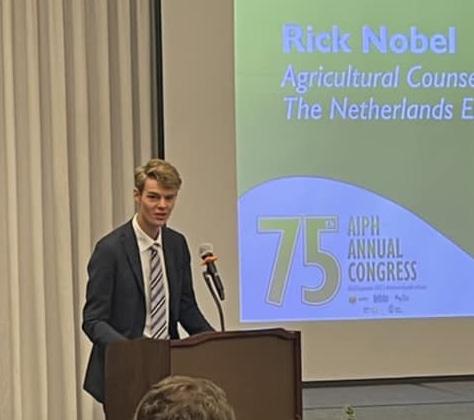
Due to the decline in the Korean floriculture industry, there is dissatisfaction among consumers about locally grown plants. Issues include a relatively short vase life for local cut flowers and a high price compared to imported products. “Young consumers are seeking new
varieties and colours, which the local market cannot provide.” Rick noted. All of this presents foreign producers a perfect opportunity to capitalise on the demand. Imports of cut flowers in particular have seen a significant increase. Popular flowers include roses, carnations, and chrysanthemums.
ENVIRONMENTAL FOOTPRINTING
Environmental footprinting in horticulture was the topic for the afternoon of AIPH's Industry Conference.
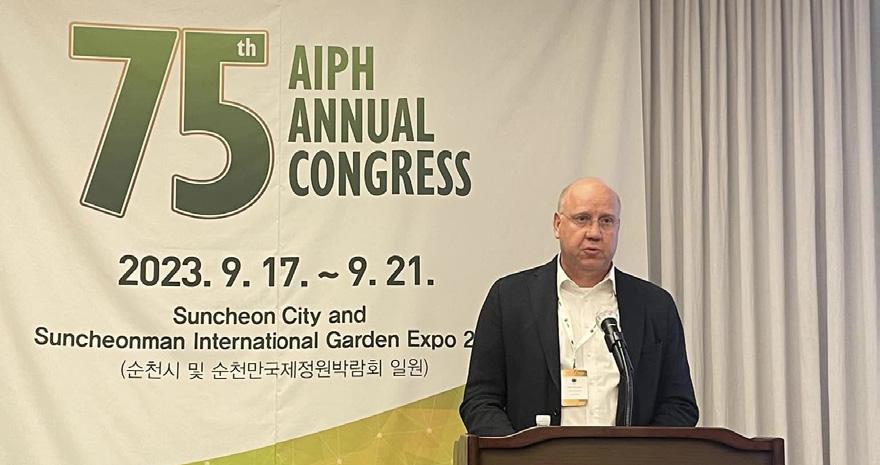
“The environmental impact of horticultural products is under debate,” said Mr. Albert Haasnoot, Sustainability Manager for Royal FloraHolland. Albert is the lead commissioner of the EU Product Environment Footprint Category Rules for floriculture (FloriPEFCR), which is currently in development.
“Growers and stakeholders in the floriculture sector are frequently asked questions such as ‘How do you deal with water?’ and ‘How much plastic do you use?’. Reliable insight into the environmental impacts of horticultural products provides great opportunities, such as supporting growers to reduce their impact and mitigate emissions.”
Transparency has become increasingly important to retailers and consumers, leading to products being labelled with the details of their environmental impact. However, the data on these labels use different methods to arrive at their final figures.
Albert continued: “Comparability is questionable. There is a risk of greenwashing as companies can make claims without substantiation. Companies
that make a real effort are not recognised for their work.”
This is where the FloriPEFCR comes in. It aims to achieve harmonised rules for calculating the environmental footprint of potted plants and cut flowers within the framework of the European Commission’s Product Environmental Footprint. The methodology will help prevent greenwashing by providing an industry standard.
The FloriPEFCR reviews the life cycle of a product and assesses the stages against 16 documented impacts. This produces a map of a product’s footprint throughout its lifetime, indicating when and where the hotspots are. Producers can then work on reducing these hotspots. A labelling process for external communication based on the data the FloriPEFCR provides is currently in development. MPS, a certification scheme based in the Netherlands, is part of the working group for the FloriPEFCR. Area Manager Mr. Arthij van der Veer joined the Conference to present the HortiFootprint Calculator, which is one of the tools used in the FloriPEFCR project.
Arthij explained: “Today, more than ever, we see a lot of questions about the sustainability of our floriculture products. Demand for environmental information is rising.”
The HortiFootprint Calculator is a software tool that growers can use to assess their environmental impact and make more sustainable choices. To use the tool, growers input their data and are presented with a dashboard of their results. From there, they can make decisions about how to improve their production. “We are working with growers to take this step-by-step,” Arthij commented. “It is a complicated matter, so we need to make it accessible for growers so they can continue to produce beautiful flowers.”
Recordings of the presentaions at AIPH Industry Conference are available to watch on-demand at www.aiph.org/ event/75th-annual-congress
WWW.FLORACULTUREINTERNATIONAL.COM 37 AIPH NEWS
(Below) Mr Albert Haasnoot, Sustainability Manager for Royal FloraHolland.
(Left) Mr Rick Nobel, Agricultural Counsellor for the Netherlands in the Republic of Korea.
cut flowers in
Maintains the quality of the flowers
Reusable (± 80 - 100 times)





Very solid and robust packaging for use at nursery, retailer & exporter/importer
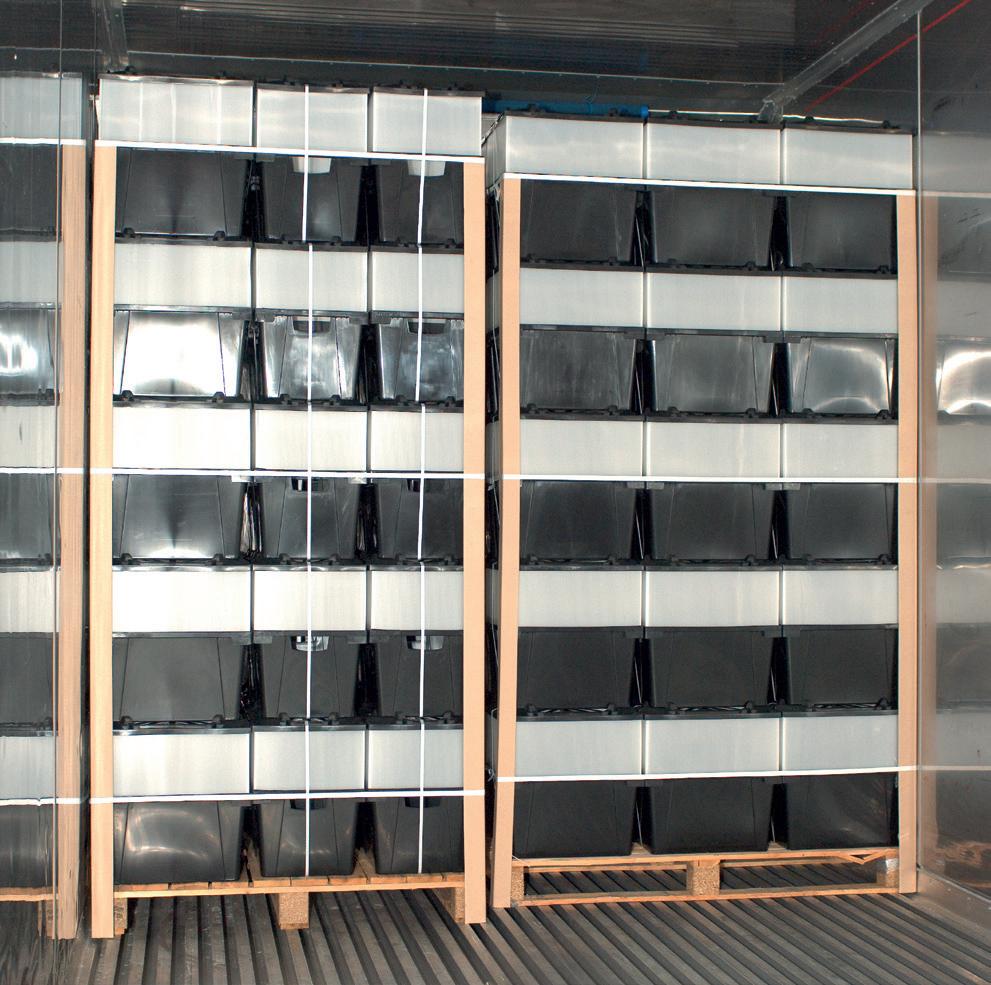
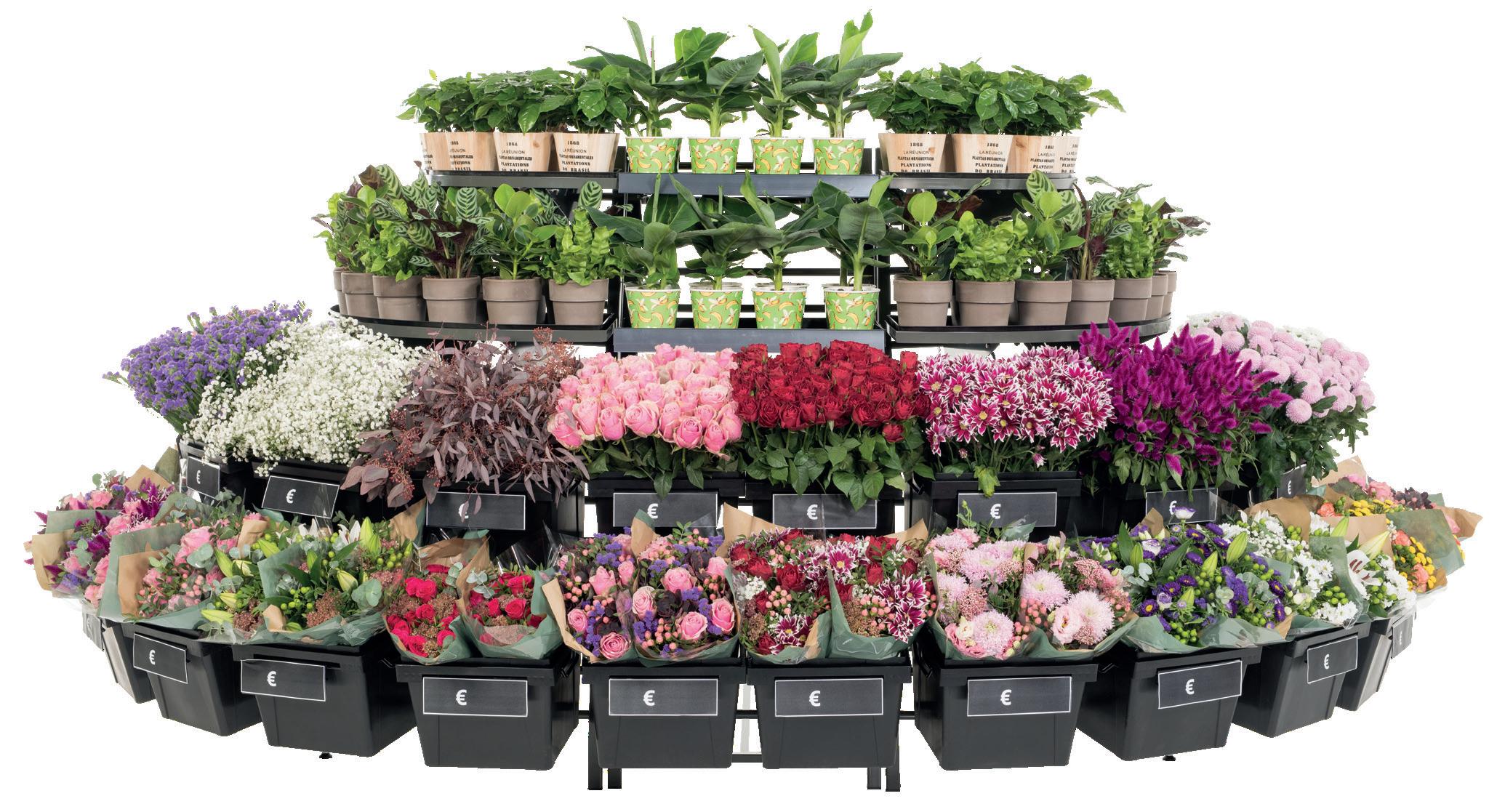

Topframe available for long stemmed flowers
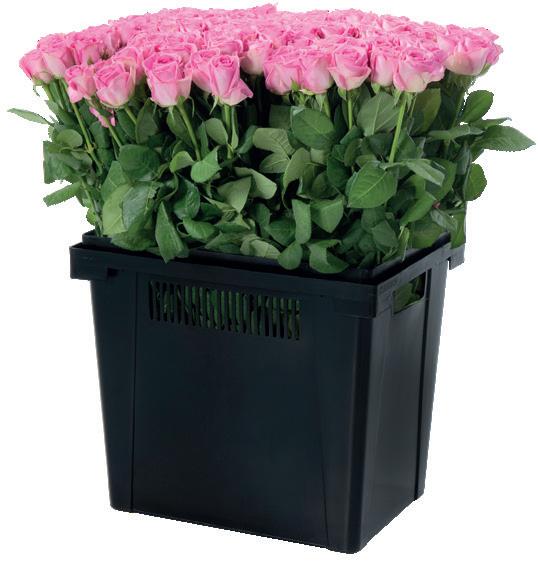
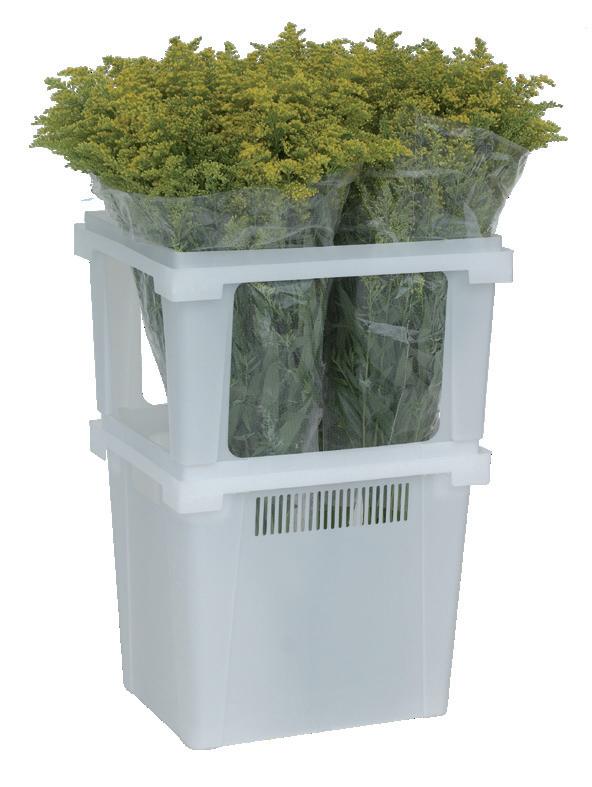
Reduction of packaging waste by re-use
Less handling, so less waste of flowers
Savings on transport costs

Easy to handle

Procona, the sustainable packaging for shipping
water by land, by air or by sea
Pagter | Emmerblok 32 | 4751 XE Oud Gastel | Netherlands | T + 31 (0) 165 39 55 00 | E info@pagter.com www.pagter.com Visit us at the IFTF STAND A2.32 8 -10 november 2023 Expo Greater Amsterdam Reliable global partner for more than 30 years!
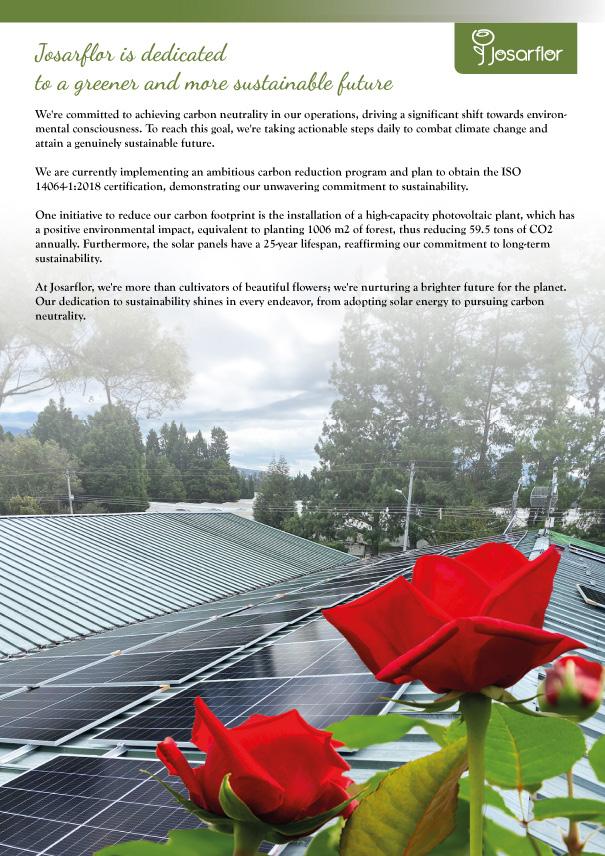
Visit us at IFTF 2023 BOOTH C1.16
Jacobacci & Associati ís a Law Firm that has, since the day it was founded in the mids-1990s, specialízed in the field of Intellectual Property, with a practice area dedicated entirely to the protection of New Plant Varieties, specifically focusing on the flower industry. Thanks to the experience we have gained over nearly two decades, our Professionals are able to offer the highest quality services in relation to contentious and noncontentious matters, updating traditional strategies and tools by means of new technologies. Because any technology has been contemporary, Jacobacci - Contemporary IP for the future.




Member to


Ms. Emanuela Truffo Individual Member Ms. Emanuela Truffo Individual Member
Jacobacci Law. Since 1996, legal defense for your plant varieties.

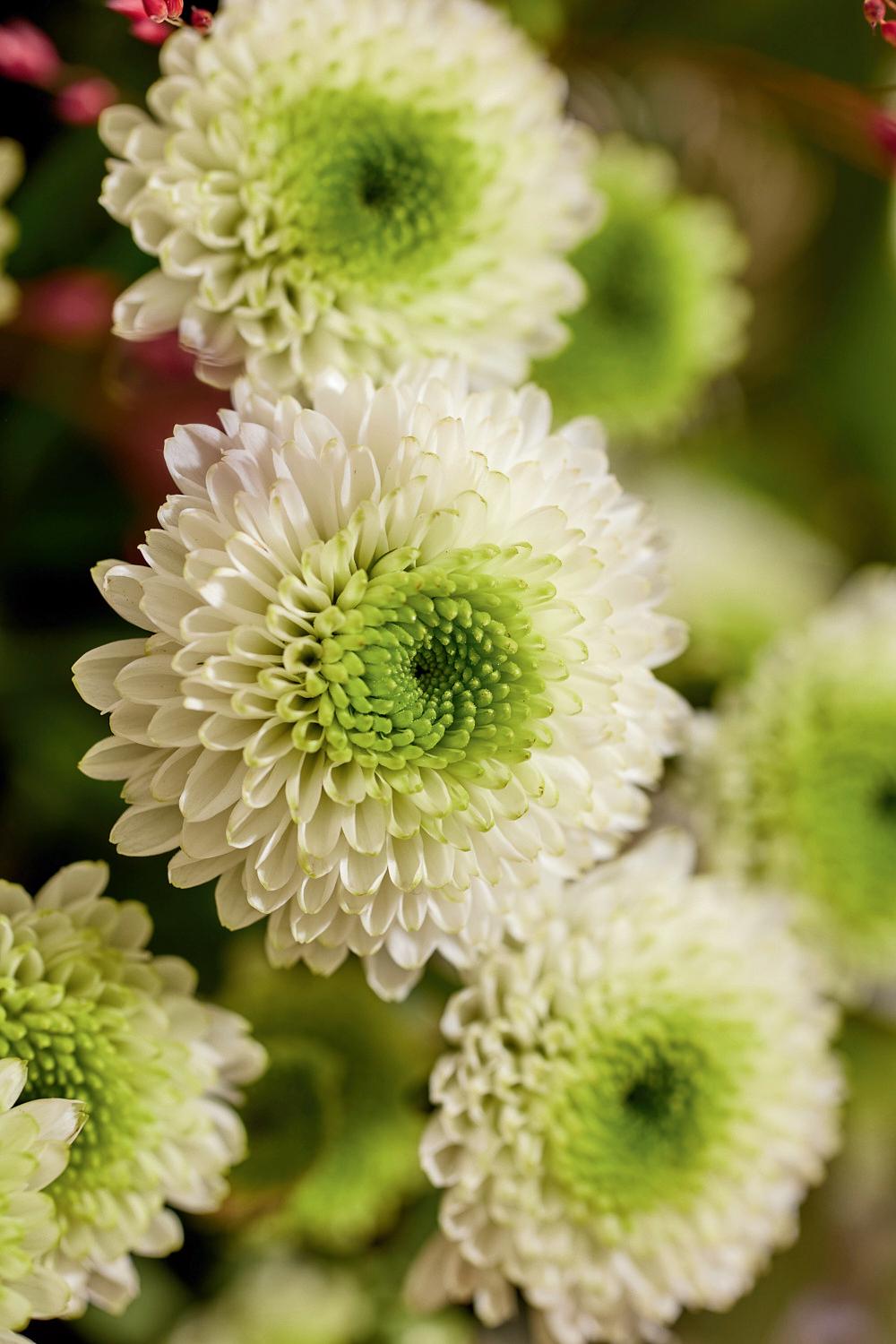


Trade Fair Aalsmeer Stand 5.16 floritec.eu
















































































































































































 MAGGIORE GRANDE MEDIO PICCOLO
MAGGIORE GRANDE MEDIO PICCOLO






























